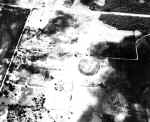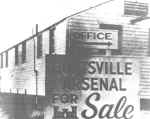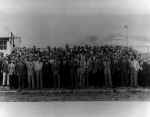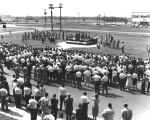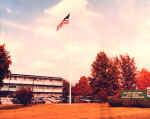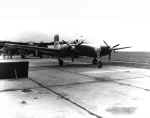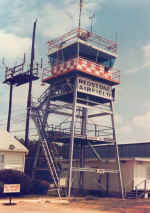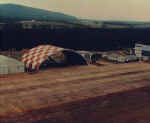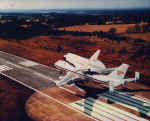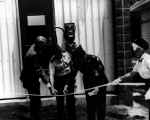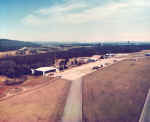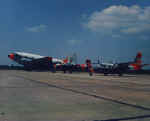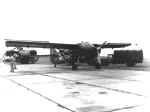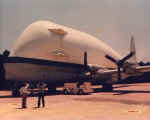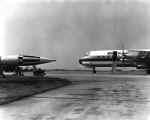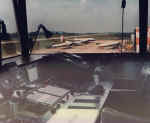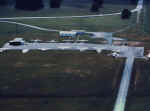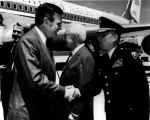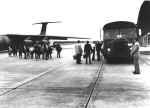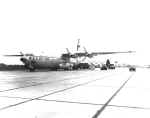|
Index:
|
|
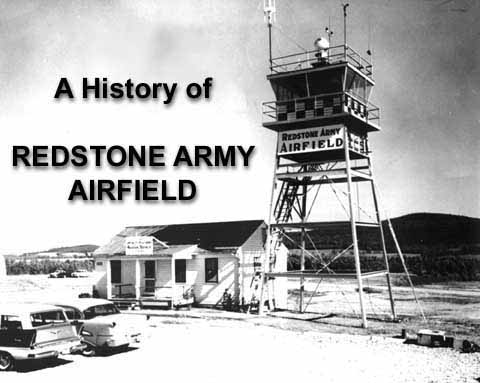
|
The history of aviation at Redstone Arsenal can be traced to the installation's World War II beginnings. Originally part of the Chemical Corps' Huntsville Arsenal, the airfield was established to accommodate the planes used to test incendiary munitions manufactured during the war not only at Huntsville and Redstone Arsenals but those produced by other Army Installations and contractor facilities across the country. With the cessation of hostilities in 1945, the airfield began an 11-year hiatus during which time no planes were assigned to it. In this period, the airfield was largely vacated and served primarily as a landing strip for transient aircraft.
By Dr. Kaylene Hughes
Introduction
The transfer of this and other Huntsville Arsenal land and facilities in June 1949 to neighboring Redstone Arsenal, a WWII Ordnance Corps shell loading and assembly plant designated as the site of the Army's consolidated rocket and missile programs, augured well for the future of the airfield. After the activation of the Army Ballistic Missile Agency at the Redstone Arsenal complex in February 1956, the former landing strip became a fully operational Army airfield, complete with assigned aircraft, aviation personnel, an air traffic control tower, and modern radar and communications equipment.
The story of Redstone Army Airfield is best understood within the context of the arsenal's history. Consequently, chapters 1 and 2 deal first with the organizational history of the various commands that over the years have called the post home. Both sections then provide details about the mission, organization, and facilities of the airfield itself. The first chapter covers the pre-missile era, while the second chapter describes the bulk of the arsenal's history as the nerve center of the Army's accomplishments in missilery and space.
The third chapter chronicles the airfield's major functions for providing the high level of aviation support required by the Army's diverse missile and rocket activities at Redstone Arsenal. Also included is the service rendered by the airfield to other tenant organizations at Redstone, other branches of the U.S. military, the Redstone Arsenal Flying Activity, various transient civilian and foreign aircraft, and local communities in north Alabama. The final chapter discusses the important visitors who have used the airfield's facilities as well as the different special events hosted by the airfield. A chronology details some of the highlights in the history of Redstone Army Airfield.
Chapter 1
The Pre-Missile Era -
World War II Period, 1941-45
The Establishment of Huntsville Arsenal
In April 1941, Congress approved funds for the construction of a chemical manufacturing and storage installation to supplement the production of the Chemical Warfare Service's only chemical manufacturing plant at Edgewood Arsenal, Maryland. Subsequently, on 3 July 1941, the War Department announced that a site on the southwest edge of Huntsville, Alabama, had been selected as the location for a new chemical munitions manufacturing and storage plant. The official name of the new installation--Huntsville Arsenal--was announced on 24 July 1941.
The first commanding officer of Huntsville Arsenal arrived on 4 August 1941 and broke ground for initial construction of the installation. By March 1942, the arsenal's first production facility had been activated. Huntsville Arsenal became the sole manufacturer of colored smoke munitions and was also noted for its vast production of gel-type incendiaries. The arsenal also produced toxic agents such as mustard gas, phosgene, lewisite, white phosphorous, carbonyl iron, and tear gas. During World War II, more than 27 million items of chemical munitions having a total value of more than $134.5 million were produced. Personnel of Huntsville Arsenal won the Army-Navy E Award four different times for their outstanding record in the production of war equipment.
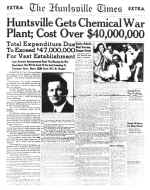
Genesis of the Arsenal Airstrip
In May 1943, an Army Air Forces (AAF) detachment was stationed at Huntsville Arsenal. Consisting of three officers, three enlisted men, and two planes--a B-26 and an L-20--the unit's mission was to support incendiary proofing being conducted by the arsenal's Inspection Division. The original unit stationed at Huntsville Arsenal was the 6th AAF Base Unit (Proving Ground Detachment), which was absorbed in May 1944 by the 618th AAF Base Unit (Proving Ground Detachment), whose home base was Eglin Field, Florida. The latter unit was assigned to Huntsville Arsenal from 1 April 1944 to 28 October 1945.
During the war years, Army bombers dropped more than eight million pounds of chemical munitions at Huntsville Arsenal. This testing supported the Inspection Office's mission of clearing for combat service .... all incendiary bombs produced at the arsenal here and all those turned out by other arsenals and about 15 private concerns under contract." Approximately 90 percent of the high altitude incendiary flight testing was accomplished from 10,000 feet, until the ceiling was raised to 20,000 feet near the end of the war. A Flying Fortress was to have been sent to Huntsville Arsenal to accomplish the latter task, but "...surrender came before the order was carried out. "
Although flight testing constituted only about 20 percent of the Inspection Office's total testing responsibilities, the Army aviators assigned to Huntsville Arsenal made a significant contribution to the Allied war effort. During 1 month alone in the autumn of 1944, when demand for munitions reached its peak, 500,000 pounds of bombs were tested. "In one instance local planes picked up a load at Evansville, IL, at noon one day, flew them [to Huntsville Arsenal] and results were telephoned back by late that afternoon."
Among the outstanding achievements of the Huntsville Arsenal Inspection Office during World War II were the testing of bombs used in "...the first all-incendiary raid on Japan [in March 1945]..." and negligible complaints from the European and Pacific theaters about the reliability of munitions tested at the arsenal. "...[E]fficiency, good or poor, of munitions falls back on proving ground officers. If they are good you probably won't know it, but faulty ones are sure to bring a sorching [sic] report. Therefore, in the testing game, too, no news is good news."
Because much of the work accomplished during the war years by the Huntsville Arsenal Inspection Office was being done for the first time, a lot of it without direction from higher echelons, the office had to develop new inspection techniques. One notable method established was the use of ground-to-air communication on the bombing ranges. This expedited the bomb proofing program and increased the office's safety factor.
In 1945, near the end of World War II, a rectangular airplane hangar open at both ends was built at the airstrip when fuzes had to be flown into Huntsville Arsenal. This hangar, along with Building 4809 constructed in 1943, is still in use today.
Wartime Casualties
Given the hazardous nature of the chemical munitions produced at Huntsville Arsenal, accidents and casualties were not unexpected phenomena. The installation's high level of safety consciousness and stringent safety regulations, however, held such accidents and casualties to a minimum during the war years, considering the volume of hazardous materiel produced. There were only eight fatalities in the arsenal's Operations Division (seven civilians and one Army officer) from the start of production in February 1942 through July 1945. The crews who flight tested these munitions were not immune to the dangers posed by the materiel they helped to inspect. A year before the war in Europe ended, three members of the 618th AAF unit gave their lives in performance of this duty.
Although he initially refrained from dropping any of the bombs on board because of the number of farm houses located in the vicinity, the pilot eventually released one 500-pound bomb some distance from the point of impact in an attempt to lighten the plane's load and regain altitude. An eyewitness to the accident stated that the plane caught fire while still airborne, then crashed in a cotton field north of the highway, about nine miles outside of the city of Huntsville, Alabama. Upon impact, the plane was enveloped in flames which caused the bombs to explode. Killed in the crash were 1LT Emmett J. Hale, pilot; 2LT Jerome Loeffler, bombardier; and SGT Antone Valim, engineer. Lieutenant Hale had been among the first group of AAF officers stationed at Huntsville Arsenal in 1943.
On 10 August 1944, the east-west road connecting Rideout Road with the Huntsville Arsenal Airport was named Hale Road in honor of Lieutenant Hale. The Officers' Picnic Park was named Loeffler Park in memory of Lieutenant Loeffler on 18 November 1944. Sergeant Valim was honored on 20 April 1945 when the Huntsville Arsenal reservoir, located on the west slope of Madkin Mountain, was renamed Valim Reservoir.
The Pre-Missile Era - Postwar Period, 1945-50
Huntsville Arsenal Phasedown
After V-E Day (8 May 1945), production schedules at Huntsville Arsenal for certain smoke munitions were altered to meet new requirements; increased emphasis was placed on the production of white phosphorus munitions, mustard bombs, and incendiary bombs. The ending of the war in the Far East on 14 August 1945 resulted in the immediate cessation of all of the arsenal's production activities except certain work in the Field Equipment Repair Shop and Chlorine Plant No. 1. On 20 August 1945, the Chief of the Chemical Warfare Service issued instructions to put some plants in standby storage and others in "standby under power." The following month, this policy was changed to place all plants in standby storage thereby reducing the arsenal's workload considerably.
On 9 November 1948, however, the Chief of the Chemical Corps informed Huntsville Arsenal that it was being removed from the surplus category and placed on standby status for possible use by the Department of the Air Force. When the Air Force decided not to use Huntsville Arsenal, the Office of the Assistant Secretary of the Army directed that the post be advertised for sale by 1 July 1949, with the opening of bids scheduled for 30 September. This sale never happened, however, because the Army found it needed this land for the new rocket and missile mission developing at neighboring Redstone Arsenal, an Ordnance shell loading/assembly plant located close to Huntsville Arsenal. The only Government-owned and operated arsenal established by the Ordnance Department during World War II, Redstone Arsenal had produced such items as burster charges, medium and major caliber chemical artillery ammunition, rifle grenades, demolition blocks, and bombs of various weights and sizes.
Advent of the Rocketry and Missilery at Redstone Arsenal
During the summer of 1948, an extensive survey of all Ordnance installations was made to find suitable land and facilities to permit activation of a rocket center for the Army's expanding work in this field. The Chief of Ordnance designated Redstone Arsenal as the center of research and development activities in the field of rockets and related items in October 1948. On 1 June 1949, he officially reactivated the arsenal as the site of the Ordnance Rocket Center. Huntsville Arsenal, on the other hand, ceased to exist as a separate installation at 2400 on 30 June 1949. Its remaining personnel were transferred to Redstone Arsenal, which also assumed the functions necessary for providing internal security and maintaining essential utilities for lessees pending the final disposition of Huntsville Arsenal's land and property.
To increase the economy and efficiency of the Army's missile program, on 28 October 1949, the Secretary of the Army approved the transfer of the Ordnance Research and Development Division Sub-Office (Rocket) at Fort Bliss, Texas, to Redstone Arsenal. Among those transferred were Dr. Wernher von Braun and his team of German scientists and engineers who had come to the United States after World War II under Operation Paperclip. Effective 1 April 1950, DA officially discontinued Huntsville Arsenal and consolidated the major portions of its land and facilities with Redstone Arsenal to accommodate the newly transferred Ordnance Research and Development Division Sub-Office (Rocket).
With the arrival of the Fort Bliss group starting on 15 April 1950, Redstone Arsenal officially entered the missile era. The Ordnance Research and Development Division Sub-Office (Rocket) was redesignated the Ordnance Guided Missile Center after its transfer to Redstone Arsenal. One year later, the arsenal assumed responsibility for the national procurement and field service missions. In addition to basic and applied research, development, and testing of free rockets, solid propellants, jatos, and related items, the arsenal was now charged with research and development of guided missiles.
Airstrip Operations
The 618th AAF Base Unit (Proving Ground Detachment) ended its tour of duty at Huntsville Arsenal in October 1945. With the cessation of incendiary testing and the departure of the 618th, the Huntsville Arsenal airstrip was largely vacated, although it continued to serve as a landing field. When the Office of the Assistant Secretary of the Army ordered the Corps of Engineers in 1948 to advertise the sale of Huntsville Arsenal, the airstrip (listed as Item 77, Tract 16) was included among the land and facilities to be sold. The sales brochure prepared by the Corps of Engineers described the facility as a Class "C' airstrip, measuring 150 feet by 5,000 feet. It was designed for either a 37,500-pound wheel load or 75,000 pounds gross weight. Constructed of asphalt concrete, the airstrip had 500-foot turnarounds at each end and a reinforced concrete apron.
Chapter 2
Missilery and Space, 1950-91
Redstone Arsenal Complex Mission and Organization Changes
Redstone Arsenal, 1950-56
With the arrival of the Fort Bliss group in April 1950, Redstone Arsenal became the home of the consolidated Army Ordnance rocket and missile program. The following year, the Ordnance Corps expanded the arsenal's mission to include antiaircraft missiles, rocket launchers, and solid propellants, the latter two programs to be carried out in cooperation with Rock Island and Picatinny Arsenals.
In its 8 years as the commodity arsenal for rockets and guided missiles, Redstone Arsenal served as the nerve center not only for the research and development but also for the procurement, storage, maintenance, and repair of the entire family of Army Ordnance missile systems. During the period from April 1950 to March 1958, Redstone Arsenal managed several important missile and rocket programs including the REDSTONE, CORPORAL, HAWK, HONEST JOHN, SERGEANT, LITTLEJOHN,REDEYE.
In addition to its rocket and guided missile responsibilities, Redstone Arsenal also retained until 1 July 1956 the chemical ammunition missions formerly assigned to wartime Redstone and Huntsville Arsenals. Following the United States' entry into the Korean War, four ammunition production lines were reactivated from standby status and resumed production in July 1951. By the end of 1955, Redstone Arsenal was producing a major portion of all chemical artillery ammunition used by U.S. troops. Between July 1951 and July 1956, the arsenal produced over 38.7 million complete rounds of chemical artillery ammunition.
Army Ballistic Missile Agency, 1956-61
Army Ordnance Missile Command, 1958-62
On 31 March 1958, the Department of the Army (DA) created the Army Ordnance Missile Command (AOMC) because of the increasing importance of missilery and the pressing need for exploiting resources to their maximum capability. A Class 11 activity under the jurisdiction of the Chief of Ordnance, the new command was headquartered at Redstone Arsenal. It was the largest field organization within any of the Army's technical services in number of personnel directly engaged, value of facilities, number of weapon system programs under its control, and dollars allotted. The subordinate elements of AOMC included ABMA; Redstone Arsenal; the Jet Propulsion Laboratory (JPL) at the California Institute of Technology in Pasadena, California; and White Sands Proving Ground (later renamed White Sands Missile Range), New Mexico.
Establishment of ARGMA.
Another subordinate element of AOMC was the Army Rocket and Guided Missile Agency (ARGMA), which was created on 1 April 1958. Although not officially established as an activity under the jurisdiction of the Chief of Ordnance until 1 June 1958, ARGMA assumed the technical missions formerly assigned to Redstone Arsenal. The primary mission of the latter organization became that of providing support and housekeeping services for the entire arsenal complex. Redstone Arsenal was subsequently replaced as the support element of AOMC on 1 June 1961 by the Army Ordnance Missile Support Agency (AOMSA), the forerunner of today's Redstone Arsenal Support Activity (RASA). With the activation of AOMSA, Redstone Arsenal became a geographical location only.
NASA Transfer
On 21 October 1959, President Dwight D. Eisenhower approved the transfer of ABMA scientists and engineers to the National Aeronautics and Space Administration (NASA). Soon thereafter, on 27 October, the Chief of Ordnance advised AOMC that the Army's work for NASA would be handled under the Cooperative Agreement of 3 December 1958 until Congress approved the transfer. The Development Operations Division of ABMA, the nucleus of which was the Von Braun team, would remain an Army responsibility until phased to NASA after Congressional approval. The Army-NASA Transfer Plan, signed by the NASA Administrator; the Secretary of the Army; and the Acting Secretary of Defense on 16 and 17 December 1959, provided for ABMA's continued performance of military weapon systems missions and permitted NASA to establish a substantially independent space vehicle research and development organization located on Redstone Arsenal. Final approval of the Army-NASA Transfer Plan was obtained on 15 March 1960.
AOMC Reorganization
As part of the reorganization of AOMC, both ABMA and ARGMA were abolished on 11 December 1961, and their functions and personnel were merged with AOMC Headquarters. Knowledge of the pending Army-wide reorganization heavily influenced the consolidation and restructuring of the Ordnance Missile Command. At that time, AOMC established project offices for 14 of the weapon systems under its jurisdiction. Shortly thereafter, the White Sands Missile Range was removed from AOMC's jurisdiction and placed directly under the Chief of Ordnance effective 1 January 1962. All of these actions subsequently helped to smooth the transition from AOMC to the new command which was established at Redstone Arsenal as part of DA's reorganization in l962.
U.S. Army Missile Command, 1962-1997
MIRCOM/MIRADCOM, 1977-79.
In compliance with the recommendations of the Army Materiel Acquisition Review Committee (AMARC), MICOM was abolished on 31 January 1977. Its missions and personnel were divided between the Army Missile Materiel Readiness Command (MIRCOM), which was oriented toward missile readiness, and the Army Missile Research and Development Command (MIRADCOM), which was dedicated to missile acquisition; research and development; and initial procurement. This divided command structure lasted until 25 April 1979, when DA approved the merger of MIRCOM and MIRADCOM into a single organization in order to reduce duplication, improve efficiency, eliminate interface and transition problems, and maximize the use of dwindling resources. On 1 July 1979, MICOM was reactivated in the first part of a two-phase merger process completed in October 1979. Other realignments to streamline and optimize the consolidated command in accordance with DARCOM approved organizational concepts followed in 1980 and 1981.Program Executive Officers
Another significant mission and organization change occurred at Redstone Arsenal on 1 May 1987 with the provisional establishment of four Program Executive Officers (PEOs). The PEOs were a primary element of the Army's restructured acquisition process. Under this reorganization, the Under Secretary of the Army was appointed as the Army Acquisition Executive (AAE). The PEOs reported directly to the AAE, while the program/project managers (PMs) reported directly to their respective PEOs and the AAE. The PEOs/PMs accomplished their missions through the use of functional personnel and facilities supplied by the major subordinate commands (MSCs).
Initially established at Redstone Arsenal were the PEOs for Forward Area Air Defense (FAAD), Close Combat Missiles, Fire Support, and High/Medium Air Defense (HIMAD). The following year, on 15 September 1988, the AAE directed changes in the PEOs located at the arsenal as part of the overall realignment of the Army PEO structure. As a result of this reorganization, the FAAD and HIMAD PEOs were joined to form the new PEO for Air Defense, while the PEOs for Fire Support and Close Combat Missiles combined to form the PEO, Fire Support.
Through the years as Redstone Arsenal evolved into the complex which exists today, the installation's airfield also expanded to keep pace with the numerous changes affecting the center of the Army's rocket and missile development programs. Despite all of the realignments and redesignations that have occurred, the airfield's primary responsibility has remained basically the same: to provide the essential flight support necessary to achieve the arsenal complex's assigned missions.
Organization
In the past 40 years, Redstone Army Airfield has undergone several organizational changes, in keeping with the realignments affecting the entire arsenal complex. The first of these changes was preceded by MG John B. Medaris' decision in November 1955 to create an Aviation Section within ABMA, the new Army organization to be located at Redstone Arsenal. Medaris, the new agency's first commanding general, made this decision 2 months before he actually began directing the long-range missile development projects at Redstone Arsenal.
After ABMA was activated on 1 February 1956, General Medaris ".... requested that the Arsenal air strip be completely turned over to [ABMA] as the responsible agency for operations and security," since it was the only organization "...operating aircraft from the air strip physically located at Redstone Arsenal." In response to this request, the Redstone Arsenal Commander, BG Holger N. Toftoy, turned over the airfield to ABMA, along with the "structures thereon and appurtenances thereto," effective 1200, 15 February 1956.
The airfield became part of the Aviation Section which had been established in the early months of the agency's operation by MAJ Henry R. Del March, Chief of the ABMA Transportation Branch, Headquarters Commandant. In May 1956, the Aviation Section was moved from the Transportation Branch and became a separate element under the jurisdiction of the Headquarters Commandant.
As previously mentioned, AOMC was activated on 31 March 1958 with ABMA as one of its subordinate elements. On 1 May 1958, Del March was named as Chief of the AOMC Transportation Office. Most of the functions of the branch which he had headed at ABMA were transferred to AOMC on 9 May 1958. As part of this realignment, the Aviation Section was assigned to the AOMC Adjutant General for administration, although it was placed under the operational control of the AOMC Transportation Office. The latter organization actually provided military air transportation services and operated Redstone Army Airfield for the command.
Effective 15 April 1960, the mission and functions of the Aviation Section, AOMC Adjutant General, were transferred to Redstone Arsenal, less operational control of such missions and functions retained in AOMC Headquarters. This activity was established as an organizational element of Redstone Arsenal and reported directly to the Deputy Commander. Redesignated the USAOMC Army Aviation Division, the organization was responsible for providing military air transportation service for the installation as well as operating the airfield.
During the first half of 1961, the Military Air Office was transferred from the Post Transportation Division to the USAOMC Army Aviation Division. Later that same year, on 1 November 1961, the Aviation Division was placed under the jurisdiction of the Post Transportation Division, another element of the Army Ordnance Missile Support Agency which had replaced Redstone Arsenal as the support element of AOMC. Renamed the USAOMC Army Aviation Branch, the organization was charged with administering and maintaining assigned aircraft and Redstone Army Airfield, providing military air transportation service, and operating the airfield for the command. On 20 November 1961, the Aviation Branch was assigned the additional function of scheduling military aircraft.
The latter change was made in conjunction with verbal orders of the AOMC Commander directing that those technical service functions (engineer, signal, transportation, etc.) directly related to post or installation functions at Redstone Arsenal be transferred from AOMC Headquarters staff offices to AOMSA. By the first half of 1962, the Aviation Branch consisted of four sections: Operations, Maintenance, Supply, and Schedule. Later that same year, however, the USAOMC Army Aviation Branch was redesignated the Army Aviation Branch, and its four sections were merged into two: Supply and Maintenance, and Schedule and Operations. On 20 December 1966, the MICOM Staff Aviation Office was provisionally established. The new element, which functioned as a Special Assistant, served as the principal staff advisor to the Commander, exercising staff supervision and coordination over MICOM's aviation activities. This office assumed the staff aviation mission and functions formerly assigned to the Installation and Services Office.
LTC Samuel E. Tillery, Jr., who headed the Army Aviation Branch under the Post Transportation Division, was dual-hatted as the Chief of the Staff Aviation Office, which became permanent effective 21 May 1967. During the closing months of 1969, however, the Staff Aviation Office ceased to exist as a separate Special Assistant, even though the head of the Army Aviation Branch continued to serve as the Staff Aviation Officer.
With the establishment of the Redstone Arsenal Support Activity (RASA) on 4 January 1971, the Army Aviation Branch became the Flight Operations Division and consisted of three branches: Flight Operations and Administration, Air Traffic Control and Operations, and Supply and Maintenance. The chief of the new division remained dual-hatted as the Staff Aviation Officer. During the MIRCOM/MIRADCOM split from 1977 to 1979, Redstone Army Airfield, along with the rest of RASA, fell under MIRCOM's jurisdiction. In FY 1987, the Flight Operations Division became the Flight Operations Directorate as part of RASA's compliance with the Army’s Standard Installation Organization (SIO) structure.
Personnel
As previously mentioned, Medaris inaugurated the ABMA Aviation Section in November 1955 with two pilots and one airplane. Shortly thereafter, two more pilots and an L-20 cargo plane were added. The first officer to head ABMA's Aviation Section was CPT William H. Ballard, who was appointed to this position in May 1956. At that time, all of the other personnel assigned to the Aviation Section were also pilots. CPT John K. Self served as the operations officer; CPT Loren L. Glen was the section's maintenance officer; and LT Leonard B. Cram served as the assistant supply officer. There was also one U.S. Navy pilot, Lieutenant Commander Simon J. Burtschell, Jr., stationed at Redstone Army Airfield.
By January 1958, less than 2 years after Redstone Army Airfield had been reactivated, the Aviation Section had grown from 2 pilots to 9, with 29 ground employees including maintenance and ramp men as well as tower and GCA operators. As activity at the airfield continued to increase, the number of personnel needed to handle the additional traffic expanded to meet the demand. B. J. Richey, a correspondent with The Huntsville Times, noted in a 1968 article on Redstone Army Airfield that, "On days when all four military services are using the airfield as refueling stops, just about all of the 63 personnel assigned to the branch stay busy."
Personnel reductions caused by budget cuts, as well as reductions in air traffic as a result of escalating fuel costs, have been responsible for the declining number of airfield employees in the past two decades. As of 30 September 1988, RASA's Flight Operations Directorate was assigned 56 employees (4 officers, 3 warrant officers, 34 enlisted, and 15 civilians). The following fiscal year (FY), the directorate lost 11 enlisted personnel positions. This cut, along with other changes in airfield personnel, left the organization with a total of 44 employees (4 officers, 4 warrant officers, 24 enlisted, and 12 civilians) at the end of FY 1989.
RSA Pilots.
During the years since the reactivation of Redstone Army Airfield in 1956, the aviators who have served at Redstone Arsenal have been some of the Army's best. In September 1959, MAJ Don R. George, head of the AOMC Aviation Section, related that the organization's 12 Army aviators' combined experience [added] up to 130 years and 42,000 hours of flying time--over 3,000 of those hours in combat in World War 11 and Korea." Of those 12 pilots, 8 were helicopter qualified; 2 were instrumented flight examiners; and 6 held special instrument certificates. All of the fixed-wing pilots were instrument rated, while all eight helicopter pilots were qualified as flight instructors.Experience continues to be a key trait among the Army aviators operating out of Redstone Army Airfield. During a newspaper interview in March 1988, MAJ Charles D. Richmond, then the MICOM Staff Aviation Officer and Director of Flight Operations, revealed that, "All but three of our [11] pilots have combat experience. Our flying hours range from 700 hours to a high of 17,000 hours. Among our pilots there is a total of 178 years of flying experience."
The Flying Generals.
Three of the Army pilots who have operated out of Redstone Army Airfield in the past were better known for the high profile positions which they held while at Redstone Arsenal than for their abilities as aviators.MG John B. Medaris, MG John A. Barclay, and MG August M. Cianciolo constitute Redstone's trio of flying generals:
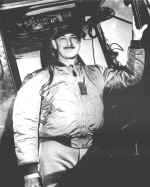
Medaris |
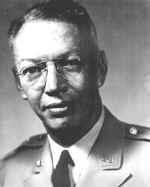
Barclay |

Cianciolo |
Medaris, who received his silver pilot's wings from the Army Aviation School at Fort Rucker, Alabama, in June 1957, was one of the Army's highest ranking officers to complete flight training. In his 4 years as the Commanding General of ABMA and later AOMC, he piloted Army aircraft a total of 1,237 hours. Of those hours, 67 were flown at night, while 196 were flown under instrument flying conditions. As the Army's senior pilot, Medaris "...spent nearly 52 full, 24-hour days in the cockpit of his Army plane..." before he retired on 31 January 1960.
Barclay, ABMA Commander from 1958 to 1960 as well as Deputy Commanding General of AOMC from 1960 until his retirement in June 1961, was the second of Redstone Arsenal's highest ranking officers to win his pilot's wings. After he graduated from the Army Aviation School at Fort Rucker in 1958, he became ". . .one of the most active pilots..." on the airfield's roster of aviators. An avid flyer, Barclay, like Medaris, was "...usually at the controls on his trips about the country."
The last of Redstone Arsenal's flying generals, Cianciolo served as MICOM Commander from July 1988 to September 1989. Unlike the arsenal's other two high-ranking aviators, however, Cianciolo earned his pilot's wings before he was assigned to Redstone Arsenal. His broad background as an Army aviator included combat experience gained during two tours in Vietnam. Among the awards and decorations received by Cianciolo are the Air Medal with "V" device and the Master Army Aviator Badge. While Commander of MICOM, Cianciolo served as a "fill-in pilot" and assisted with helicopter cargo flights being handled by Redstone Army Airfield.
Facilities
Before ABMA
Between October 1945, when the 618th AAF Base Unit was removed from Huntsville Arsenal, and February 1956, when ABMA assumed operational control of the airstrip, Redstone Army Airfield was "...largely vacated." Although the airstrip, with its 5,000-foot runway, continued to function as a landing field, there were no planes or ground crew assigned to it during this period. Contemporary accounts of the visit to Redstone Arsenal made by Army Chief of Staff GEN Matthew B. Ridgway in January 1954 reveal just how primitive the arsenal airstrip was at that time.Various arsenal officials and other important visitors gathered at the airfield on the appointed day to greet Ridgway and his party. But the group waiting on the ground at Redstone Arsenal became concerned when the general's pilot initially headed for the Huntsville Airport rather than the installation's landing strip. "The Constellation [carrying Ridgway's party] was first sighted over Huntsville Airport, giving quite a fright to the waiting dignitaries" at Redstone, who feared that the pilot would land at the civilian airport.
Since the arsenal airfield had no radio with which to communicate, there would have been no way to redirect Ridgway's plane to the correct field had another plane not been on the arsenal's landing strip at the same time. As it turned out, however, the pilot of a Globemaster on the ground at Redstone Arsenal used his radio to contact Ridgway's plane and redirect it to the right course.
The Fifties
Extensive renovations of the airfield were undertaken after Redstone Arsenal turned over the facility to ABMA in February 1956. An operations building, housing office space; a passenger waiting room; and communications equipment, was constructed by May. In addition, two 12,000-gallon underground gasoline tanks were installed and an oil storage facility was built. With the establishment of the ABMA Aviation Section and the subsequent improvement in the arsenal's available airfield facilities, Redstone Army Airfield soon became a center of military air traffic; both ABMA and the U.S. Navy stationed aircraft at the field.
But even more important than these improvements was the Army's decision to establish a Civil Aeronautics Authority (CAA) approved air traffic control tower at Redstone Army Airfield. When ABMA first reactivated the facility in February 1956, there was still a minimum amount of traffic making use of the arsenal's airfield. The rapidly growing air travel needs of the city of Huntsville as well as ABMA's expanding missile program soon made it imperative that a federal airway be established through Huntsville from Chattanooga, Tennessee, to Muscle Shoals, Alabama. Before this airway could be established, however, it was necessary for air traffic control facilities to be installed in the Huntsville area. Although the city had been interested for a long time in building such a facility and obtaining better flight service, little progress had been made.
On 12 April 1956, the mayor and other officials of Huntsville met with ABMA's Commander, Signal Officer, and Aviation Branch Chief to discuss this situation. Because the establishment of a federal airway through Huntsville would be mutually beneficial for the arsenal and the city, the ABMA Commander agreed to build a control tower at Redstone Army Airfield to handle both military and commercial air traffic pending the establishment of facilities at the Huntsville Airport. The Signal Office was tasked to coordinate the necessary action to be taken by the various agencies involved.
Signal Corps representatives, Huntsville city officials, Alabama Congressman Robert Jones, and staff members from Alabama Senator John Sparkman's office met with CAA officials in Washington, D.C., on 24 April 1956 to obtain approval for the proposed airway. The CAA agreed to establish the airway and control traffic in the Huntsville area from Memphis, Tennessee, through a tower at Redstone Army Airfield until a permanent facility was erected at the municipal airport, the latter tentatively set for 1 January 1957. Arrangements were also made to provide personnel and equipment to operate the Army control facilities through 31 December 1956. A target date of 1 July was set for the commencement of control operations at the Army airfield.
A team of Army engineers started work in May 1956 on the navigational aids and the design of needed facilities. Before Signal Corps personnel could install the necessary electrical equipment, however, a considerable amount of preliminary construction had to be completed. The Post Engineers had to construct 2 miles of road to reach the top of Ward Mountain (located on the arsenal), where a building and two 50-foot antenna towers were erected to serve the remote transmitter and receiver set. Sites were also selected for the visual omni-range and a homing beacon. All of this work was completed by 9 June 1956.
Installation of $100,000 worth of signal equipment began the following day. A 50-pair cable was laid along the 4 miles separating the remote transmitter-receiver site from the control tower. The arsenal then established direct wire circuits with the Huntsville Airport and the Memphis Control Tower. In addition, a teletype circuit linked the arsenal airfield with the CAA weather circuit in Birmingham, Alabama, providing weather data service.
The last construction projects and equipment installation were finished on 1 July 1956, just 6 hours before the new airway was inaugurated; the airfield's control tower officially began operating at 2300 hours. Ceremonies marking the opening of the renovated and expanded Redstone Army Airfield were held on 2 July. "A light plane 'riding a beam'--the first sent out from the recently erected air transportation control tower at the ABMA airstrip--... skimmed down and cut a gaily fluttering ribbon strung across the runway, to officially activate the new area control system." Carrying the ABMA Commander, the small aircraft, the first plane to land at the newly renovated airfield, cut the ribbon with its propeller. Shortly thereafter, the ABMA Commander, using a conventional pair of scissors, completed the dedication ceremony by snipping a ribbon on the newly opened control tower.
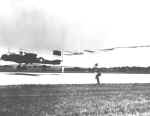
|

|
As missile and rocket activities at Redstone Arsenal continued to grow so did the installation's airfield. In January 1958, the Redstone Rocket reported that the facility was "...fast becoming a 'class A' airport. A sizeable step in that direction [came] in January [1958] with the inauguration of a ground control approach landing system, ... a radar which [allowed] technicians on the ground to 'talk down' incoming planes, regardless of visibility limitations."
By late 1959, the arsenal's days of being forced to depend on visiting pilots and their aircraft radios were long gone. At the end of the decade, the airfield's own Tower Unit monitored radio facilities essential to all-weather operation. A Radar Approach Unit handled incoming aircraft when cloud ceiling and visibility dropped below 500 feet and 1 mile. The Flight Dispatch Unit provided the link between Redstone Arsenal's control tower and aviation control agencies at Maxwell Air Force Base (AFB), Montgomery, Alabama; the Memphis, Tennessee, Air Route Control Center; and the Huntsville Approach Control Center.
The airfield's Avionics Unit maintained 29 aircraft radio transmitters and 72 aircraft radio transceivers. In addition, 8 transmitters and 9 receivers were kept in the control tower; 10 transmitters and 11 receivers were maintained for the radar approach system; while the Avionics Unit supported 5 ground stations used for navigation as well as the radio complex on top of nearby Squirrel Hill.
The 1959 layout of the airfield's weather equipment was believed to be unique in continental Army installations. Weather conditions over the nation [were] reported hourly by teletype. A facsimile machine [produced] charts prepared by the U.S. Weather Bureau in Baltimore, Maryland. Teletype forecasts [were] also received." Among the available observations accoutrements at Redstone Arsenal were equipment to measure the height of the cloud ceiling, visibility, temperature, dew point, atmospheric pressure, and wind direction and velocity. Direct phone lines also tied the airfield into the Huntsville Weather Station and the Military Flight Service forecasts at Maxwell AFB.
Because the airfield's original 5,000-foot runway was "…inadequate and unsafe for the fully loaded heavy transport aircraft required to carry JUPITER and other large missiles," plans were developed in October 1957 for a 2,500-foot runway extension and expansion of the taxi strip and parking apron. The final design directive was received by 30 June 1959 to lengthen and improve the runway and install runway and taxi strip lighting. Projects for a fire station, a new hangar, new taxi strips, and an enlargement of the parking apron--all of which were required to provide adequate facilities for the efficient operation of the airfield--were programmed into the arsenal's FY 1961 Military Construction, Army (MCA) plan.
The Sixties
As scheduled, in November 1960, the Army Corps of Engineers awarded a $479,000 contract "...to R. G. Foster and Company of Wadley, Georgia, for strengthening and extending the Redstone Army Airfield runway [by 2,300 feet] to enable it to handle large ferry planes carrying missiles and missile components." Later that same month, the Corps of Engineers solicited bids for an airfield lighting system for the new 7,300-foot runway, a 1500-foot approach lighting system, and new electrical systems. In addition, bids were opened on 22 November 1960 for the construction of a fire and rescue station adjacent to the runway. Previously, in August 1960, a telephone crash rescue system had been installed at the airstrip.The Seventies.
There was some discussion in 1970 about moving MICOM's flight operations from Redstone Army Airfield to the Huntsville-Madison County Jetport, once the latter acquired radar facilities. Although the municipal airport authority favored such a move, offering the Army at least 10 acres of leased land at the jetport, MICOM officials rejected an Army-initiated study on the question. Security issues for the Army as well as logistics problems for MSFC were key reasons in the command's decision not to move its aviation activities.Despite these changes and additions, Redstone Army Airfield remained "...a relatively small military airfield..." by 1978. Because of the importance of its mission, though, its facilities were "...no less complete than those of the Jetplex." Information on national weather conditions was easily accessed through military and national weather services. Radar systems at the airfield also monitored local weather conditions thereby enabling the Army controllers .... to compute the correct approach and take-off pattern for each aircraft using the field."
However, as a result of budget constraints, the small number of aircraft using the field, and the airfield's exceptional safety record," the fire and rescue station constructed in the early 1960s was discontinued during this decade and replaced by a crash rescue team organized from among the airfield's maintenance crews.
The Eighties. As part of the arsenal's continuing effort to keep its airfield up-to-date, the old air traffic control tower constructed 24 years earlier was torn down in June 1980 to make way for a new structure. Numerous upgrades over the years had made it unfeasible to renovate the existing tower. A temporary tower, "usually... used just to instruct beginning traffic controllers and… not designed to be permanent functional towers," served as the base of air traffic control at the airfield until the new tower became operational.
In 1983, the Federal Aviation Administration (FAA) selected Redstone Army Airfield to be a flight service station sub-facility, based on the amount of its air traffic and hours of operation. This new mission meant that the airfield's equipment was expanded by the addition of computer terminals so that the airfield's "...flight plans… [could] be entered directly into the international flight filing system of FAA."
Three years later, on 21 July 1986, construction began on a hangar missile test facility located at the airfield. The new facility provided space for the RD&E Center to test rotary wing aircraft with missile systems, work previously done in the high bay of the arsenal's McMorrow Laboratories (Building 5400). The hangar accommodated more aircraft and provided for better control and safety of operations. A contract totaling $5,107,565 was awarded to the Harold Construction Company of Huntsville for the project, which was completed in March 1988.
The most recent major upgrade in the airfield's facilities was accomplished in May 1988 when a communications electronics installation team from Fort Huachuca, Arizona, replaced the control tower's 35-year-old metro consoles with a modern air traffic control communication switching system. The new arrangement "provided .... …better and faster communication with both aircraft and ground units," thereby improving flight safety, because controllers could quickly inform pilots about wind changes, the presence of other aircraft, or other safety hazards. The old central telephone system was also replaced by a primary crash alarm system which was faster and easier to use.
------------------------------------------
Chapter 3
Aviation at Redstone Arsenal
Mission and Function
Since the reactivation of Redstone Army Airfield in 1956, a major function of the various organizations assigned responsibility for the arsenal's aviation activities has been to provide military air transportation for command headquarters as well as other tenant activities and customers. Another critical function is the administration, operation, and maintenance of the Redstone Army Airfield and the command's assigned aircraft. Equally important is the aviation support rendered for research, development, and test projects at Redstone Arsenal and other test sites. Another function, acquired after the Redstone Arsenal Flying Club moved back on post in the mid-1970s, involves monitoring and assisting with the club's activities.
Military Air Transportation
In May 1956, four Army pilots and three light planes were stationed at Redstone Army Airfield to provide "…vital rush transportation to key Arsenal military and civilian personnel on official business." The accelerated pace of the Army's missile and rocket research and development (R&D) program at Redstone required ".... immediate and fast transportation to many parts of the nation.' By 1958, the airfield was handling an average of 24 flights a day, and its contingent of assigned aircraft and pilots had jumped to six and nine, respectively.
The major part of the traffic [was] transient aircraft from other Army and Air Force installations. With the nation's growing emphasis on missile work, the Redstone airfield [provided] a valuable link between Huntsville and Washington, Cape Canaveral, Florida, Detroit, Los Angeles, and other important centers.
Air Force C-124's [landed] at the airstrip to haul the big Redstone and Jupiter missiles to their Florida test range. The facility [was] also in common use by representatives of Chrysler Corporation, Hayes Aircraft, and other Army contractors.
The arsenal's own fleet of aircraft was also kept busy transporting passengers and cargo all over the United States. In the first 42 months of the airfield's all-weather operations (May 1956 to September 1959), the AOMC Aviation Section logged more than 3.5 million passenger miles.
When critical situations [developed], the Command [relied] upon its own pilots and aircraft to expedite the movement of personnel, spare parts and equipment.... Material which because of security [could not] be shipped by commercial airlift [was] always handled by the Section. Often, urgent missions [had to] be flown without regard to weather.
The movement of passengers and cargo in and out of Redstone Army Airfield continued to escalate in the following decade. In 1960, AOMC aircraft had the second highest amount of flying hours per month of all Army installations worldwide. By 1968, it was "…said to be the busiest Army airfield in the nation," averaging 150 flights in a normal day. Redstone Arsenal aircraft hauled ".... cargo and personnel to all parts of the country from California to Boston."
This trend continued into the early 1970s. The larger C-47 cargo planes, which were flown by Army pilots assigned to Redstone Arsenal, "...stayed on the go constantly. The airfield experienced a really big movement of cargo and personnel..." during that period. Air transportation statistics compiled for Redstone Army Airfield in FY 1973 revealed that the Arsenal's pilots and aircraft spent a total of 6,346 hours in flight, transporting 2,196 passengers and 1,064,355 pounds of cargo. As Don Alexander, Chief of the Air Traffic Control Branch, who has worked at the airfield since 1972, recalled,
The C-47 officers used to go to Alaska routinely. We had what we called 'milk runs' that went from here to Utah and one that went up the east coast. So those guys just stayed in the air all the time. But then money and everything else kind of tightened things up. We lost the aircraft [because they] were becoming real old and hard to maintain, expensive to maintain.
Because of the nationwide energy crisis, in FY 1974, AMC instructed the airfield to reduce its consumption of aviation fuel, which the airfield did by 26 percent. The total hours flown by the arsenal's aircraft dropped to 4,599 and the number of passengers (1,087) and pounds of cargo (435,000) transported were more than halved.
The airfield's planes are often used to fly personnel to other Army posts or contractor facilities. But as former Staff Aviation Officer MAJ Michael Lopriore commented in a 1977 newspaper interview, the airfield had no VIP aircraft per se and the availability of aircraft did not guarantee free reservations. "Whatever flying hours we expend, a customer is paying for it." In a 1978 interview, MAJ Norwood Sothoron, then Chief of Flight Operations for the airfield, reemphasized this point, stating that the airfield had its ".... own budget... [and was required] to charge customers for our services and account for expenses. Very few other Army Airfields [were] run in this fashion."
Many flights involve items that commercial carriers will not take (e.g., live rocket motors) or that the Army will not ship commercially (e.g., sensitive electronic gear or classified materiel). As Dave Harris, Public Affairs Officer for MICOM, has remarked, "Because of its location, the Redstone Army Airfield is a good place to fly in classified cargo." But noted LTC William R. Laird, another of MICOM's former Staff Aviation Officers, the airfield "...is not in competition with civilian commercial transportation. There are military requirements," meaning that travel is for official business only and the airfield's services either meet time constraint requirements or are less costly. Laird also pointed out two criteria for scheduling a flight: "It must be cost effective and/or there are delivery constraints that a commercial airlines cannot support."
Over the years, the airfield has provided transportation for some rather special cargo and passengers. The original REDSTONE and JUPITER missiles built in-house under the direction of Dr. Wernher von Braun were flown in a C-124 Globemaster from the arsenal's airfield to Cape Canaveral, Florida, for testing. The JUPITER C launch vehicle which carried the Free World's first satellite--EXPLORER I--into orbit around the Earth in January 1958, began its historic journey from the arsenal to outer space via the Redstone Army Airfield. The "much-publicized space monkeys," Able and Baker, were moved around the country before and after their pioneering flight in May 1959 on planes provided by the AOMC Aviation Section. In November 1957, the airfield also furnished the aircraft which flew the JUPITER C #40 nose cone, the first man-made object to be recovered intact from outer space, to Washington, DC, for use in a television broadcast by President Dwight D. Eisenhower.
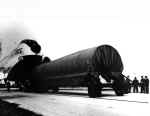
An Air Force C-124 loads |
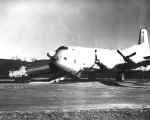
C124 unloads an Army JUPITER missile |
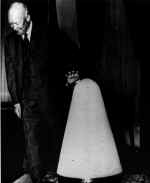
President Eisenhower displays JUPITER C #40 nose cone on national television |
More recent shipments include the one in January 1984, when the Army Transportation Museum flew a C-130 air transport to Redstone Arsenal to pick up three historic military vehicles--a Dodge command car; a Ford GP Pygmy, the first jeep; and a Willys MA--temporarily donated by Captains Randall and Margaret Withrow, who were stationed at Redstone Arsenal at that time. The vehicles were to be displayed at the museum while the Withrows served a 3-year tour of duty in Germany. In September 1988, a MICOM plane flew 1,500 original captured German World War II rocket documents to Washington, DC, for shipment to Germany. They had inadvertently been left in the collection of the Redstone Scientific Information Center when other captured documents were initially returned.
In addition to providing air transportation for passengers and cargo departing from and arriving at Redstone Arsenal, the airfield has also furnished aviation support for some unique projects. Heavy rains early in 1957 caused flood conditions which threatened to divide the arsenal by overflowing onto the last road connecting the ABMA and RSA headquarters buildings. As an emergency measure, the Aviation Section borrowed two helicopters from Fort Benning, Georgia, and established an emergency air transportation system between the isolated areas. The H-34 helicopters were also employed for general transportation purposes as well as to assist engineers conducting flood surveys on the arsenal.
The following year, military police (MP) at Redstone Arsenal made use of a small, two-seat helicopter to patrol the post's roads. The arsenal was the only military installation in the United States using such a system at that time. Besides enforcing the post's traffic laws, the helicopter was also used to conduct traffic surveys. Additional uses for the helicopter were proposed including watching for forest fires; assisting the MP patrol boats to monitor the arsenal's border on the Tennessee River; helping in flood control and storm damage surveys; serving as an emergency means of locating lost persons; and airlifting seriously ill or injured persons to the post hospital.
The airfield provided a plane in February 1965 to fly personnel from the Post Engineer's Water and Sewage Maintenance Section around the arsenal looking for "plumbing problems." As the plane slowly weaved a few hundred feet above the ground, the passengers looked for "…. any spots of green vegetation among the drying grass and shrubbery on Redstone pastures and fields," a sure sign of leaks in the water or sewer lines. "...[T]he plane [afforded] the most efficient way to check because much of the line [ran] in places not accessible by surface transportation." At least twice in the past the airfield has assisted motion picture crews shooting aerial footage at Redstone Arsenal. In March 1972, a Huey UH-l helicopter carried cinematographers from DA's Audio Visual Agency all over the installation. Several years later, in September 1985, some of the opening scenes of the film Space Camp were shot at the airfield.
When Congress delayed approval of the FY 1979 Defense Budget almost beyond the time when the Army could meet the payroll that was due on 13 October 1978, normal delivery of the soldiers' checks was not possible. Redstone Army Airfield pilots, however, at the request of the MICOM Finance and Accounting Officer, saved the day for the arsenal's troops by braving a series of dense lines of severely turbulent weather between Redstone and the Army Finance Center at Fort Harrison, Indiana, where all the checks were written. Two round trips and one plane switch later, "the pay bird landed at Redstone just before 1:00 p.m., Friday [the 13th]."
When the Test, Measurement and Diagnostic Equipment (TMDE) Support Group at Redstone Arsenal suffered a short period of time in early FY 1990 with zero funding for shipping (usually accomplished by land using contracted carriers), "another means of transportation was used: the old, reliable Army Caribou plane at Redstone Airfield." The aircraft made a trip east on 9 November 1989, stopping at Letterkenny and Tobyhanna Army Depots, both in Pennsylvania. From 13 to 16 November, the Caribou undertook a whirlwind trip west, making deliveries at Holloman Air Force Base, New Mexico; Pueblo, Colorado; Dugway Proving Ground, Utah; and Sacramento, California. Although the TMDE Support Group had never used this particular mode of delivery before, they discovered that the airfield was "...a tried and tested backup means of transportation."
Redstone Army Airfield also furnishes military air transportation support for various types of training exercises. In 1959, when White Sands was still a part of AOMC, aviators assigned to the missile range were "...rotated periodically to the Arsenal where they [received] twin-engine and instrument training from the Aviation Section. General Medaris [considered] it prudent to make full use of the extensive experience of his pilots to further qualify the WSMR aviators."
More recently, the airfield's assigned aircraft have supported training exercises such as the April 1985 preparation for the expert field medical badge test, which involved evacuation and 'dustoff' training. The latter included practice calling in a helicopter to evacuate casualties from a combat environment as well as loading and unloading stretchers. The airfield continues to assist Fox Army Community Hospital during its annual mass casualty exercises.
In May 1986, arsenal aircraft assisted the Ordnance Missile and Munitions Center and School's (OMMCS's) Conventional Ammunition Division "… to more-realistically train ammunition specialists." A helicopter hovering close to the ground was used to teach students the 'sling-out' procedure for attaching ammunition loads just as they would in emergency or combat situations. The 2-week course also provided instruction in aircraft safety and identification, landing and pickup zone determination, evacuation, and hand and arm signals for aircraft control. In addition, the airfield's helicopter crews train Officer Basic Course and NCO students in Air Assault techniques.
As part of the Joint Chiefs of Staff Gray Steel exercise in December 1987, trucks loaded with chemical munitions were driven from Anniston Army Depot to Redstone Army Airfield, where the munitions were transferred to a waiting Air Force C-141 transport. "Redstone was selected as a site for a portion of the exercise because it offered a runway long enough to accommodate the transport plane, and because the airfield could be secured… MICOM played a critical part as the aerial port of embarkation. It was the nearest usable airfield to Anniston." Civilian fire department officials from North Alabama convened at the airfield on 15 June 1989 to see a demonstration of an emergency response to a downed helicopter and to hear a presentation on a NASA airplane from Houston, Texas. Sponsored by the Redstone Fire Department, the demonstration was the main feature of the monthly meeting of the North Alabama Fire Officers Association
Airfield/Aircraft Administration, operation, and Maintenance
Airfield Operation
With the activation of Redstone Arsenal's air control tower in July 1956, the airfield became "a 24 hour a day, seven day a week operation." This strenuous schedule remained in effect for 13 years. In November 1969, however, the airfield implemented its current operating schedule of 13 hours a day, 5 days a week. During the hours when the airfield is not operating, though, its personnel are on call and, if necessary, can get the field operational in 1 hour. In addition, the airfield is an all-weather operation, able to handle incoming aircraft when cloud ceiling and visibility drop below 500 feet and 1 mile. Even on the rare occasions when the arsenal has been snowbound, activity at the airfield has not been halted for long. In February 1960, for example, a snowstorm closed the arsenal, but the airfield remained open for emergency flights. When 7 inches of snow began blanketing Huntsville on Saturday, 29 January 1966, falling so fast between the hours of 2 and 10 a.m. that road clearing efforts on the arsenal were seriously handicapped, the airfield was back in business by Sunday night. Although 11 inches of snowfall was recorded in January 1988, it did not seriously impact the airfield's routine operations. The combination of several factors, including light flying activity; quickly melting snow; and DEH's speedy response in clearing the area, opened the airfield in less than 48 hours.
Currently, other aircraft wanting to land at the arsenal's airfield must have a prior permission request (PPR), which requires 24-hour advance notice. Such permission is necessary because of the airfield's limited ramp space for moving, parking, or servicing aircraft. Ongoing missions also restrict other aircraft from using the arsenal's airfield. Civilian aircraft cannot land without a PPR unless it is an emergency. "In an emergency anybody can use the airfield because then we're concerned with the protection of life and property." Under normal conditions, civilian aircraft also must have proper insurance, and "… they can be charged a landing fee if the airfield commander so desires."
On 14 September 1960, a C-54 was assigned to the airfield for use in carrying VIP passengers to and from Redstone Arsenal. This type of aircraft "flew for years" out of Redstone Army Airfield. As Dave Harris recalled, "It took 9 hours to fly to White Sands Missile Range in a C-54, but it was longer in a C-46. Neither of these planes was pressurized, so they flew at a low altitude." Before year's end, AOMC gave up two L-23 planes to satisfy an overseas requirement. They were replaced by another U-lA DeHaviland Otter. The following year, the command's fleet of aircraft was reduced further from 12 to 7 as the result of a study on the requirements and operational costs of military aircraft at Redstone Arsenal.
As the decade of the 1960s neared its end, the number of aircraft assigned to the airfield began to increase. In 1964, there were 10 military aircraft stationed on the arsenal, while 13 planes and helicopters were reported on post by February 1968. The addition of 3 helicopters in FY 1973 to support R&D testing raised the number of rotary wing aircraft at Redstone Arsenal to 11, only 2 of which were permanently authorized. Another three helicopters were received the following year. At AMC direction in FY 1975, however, Redstone turned in three C-47s, one U8-F, and four UH-lMs. In addition, the maintenance contract on the C-54 aircraft was discontinued as uneconomical. To compensate for these losses, a YC-7 Caribou was assigned to the airfield in February 1975, but 4 months later AMC instructed MICOM to transfer this plane to the U.S. Army Aviation Center at Fort Rucker, Alabama.
The Missile Command's fleet of aircraft in January 1977 included 13 helicopters (mostly UH-1 Hueys and AH-1 Cobras) and 4 propeller-driven planes: 1 Canadian built YC-7 Caribou, a medium twin-engine transport; 1 VC-6, the military version of the Beech 90 King Air; and 2 C-45s, the venerable Beech model 18, a light twin that went into production before World War 11 The number of aircraft assigned to Redstone Army Airfield fluctuated between 17 and 18 until FY 1982 when the total dropped to 15.
In FY 1983, the Flight Operations Division turned over its YC-7 Caribou (No. 57-3080) aircraft to the aviation museum at Fort Rucker. Put into service in 1957, this particular plane was the second Caribou added to the Army's fleet of aircraft. The first Caribou in Vietnam, No. 57-3080 also served as the flagship for the president of South Vietnam. The plane flew about 10,000 hours in its 26 years of Army service. The "Y-model" Caribou prototype was replaced by a newer C-7 Caribou transferred from the USAF Reserve at Maxwell AFB, Alabama.
In 1991, the airfield had 10 assigned aircraft: 2 Short's C-23A cargo aircraft, 2 Beechcraft U-21H King Airs, 1 U-21F King Air, and 5 UH-1H helicopters modified for R&D testing. In May 1991, the airfield turned in its C-7A Caribou, the last of this type cargo aircraft on active duty with the Regular Army. The Caribou and its three-member crew made their last flight together to Amarillo, Texas, on 17 May 1991. The plane became a part of the Texas Aviation Historical Society's museum at a dedication ceremony held the following evening.
In addition to supporting the aircraft assigned to the arsenal, Redstone Army Airfield serves as a refueling stop for all of the military services. The airfield's runway is capable of handling a wide spectrum of military aircraft including some of the world's largest cargo and passenger planes. Among the aircraft which have used the arsenal's airfield are the C-124 cargo plane; the AO1C Mohawk turboprop reconnaissance plane; the Air Force's C-5A Galaxy, the world's second largest plane, capable of carrying ". . .nine buses in its cavernous fuselage and up to 75 troops in airline seats atop the bay; .. the Army's flying electronic warfare laboratory, nicknamed the "Big Crow;" and the C-141 passenger plane, the type of transport commonly used to ferry the Soviet inspectors to Redstone Arsenal during one of their inspections under provisions of the Intermediate Range Nuclear Forces (INF) Treaty. Other aircraft that have landed at Redstone Arsenal include the UH-60A Blackhawk utility helicopter, which has a cruising speed of 145 knots; the Coast Guard's HU-25A reconnaissance plane; and the Soviet Mi-24 Hind lookalike target helicopter, "...actually a converted Sikorshy H-19 helicopter, cosmetically made to look like the Soviet original…."
Redstone Army Airfield has also served as a training site for other non-RSA commands. The 101st Airborne Division, headquartered at Fort Campbell, Kentucky, has conducted night training on the arsenal. Several of the unit's operations have involved night maneuvers where the helicopters have flown at low altitudes without using their lights. In the past, the Air Force has also conducted training exercises at the airfield. For example, Sewart AFB near Nashville, Tennessee, used the airfield in the late 1960s to train its pilots on the twin-engined Caribou.
The airfield "...is also unusual in that [it is] the only Army airfield with a NASA tenant. The Marshall Space Flight Center has a support agreement with RASA and shares the field with us." This unique arrangement was established by the Army-NASA Transfer Plan signed in December 1959. Under the terms of this agreement, Redstone Arsenal was to provide air support for passengers and cargo on Army-owned aircraft on a "space available" basis at no cost to NASA. The new agency's own aircraft would also be allowed to land and take-off from the airfield without reimbursement. However, services in excess of this agreement, such as emergency maintenance or refueling, would be on a reimbursable basis. In 1971, the agreement was amended to allow MSFC to use the airfield for launching balloons as part of its Stratoscope 11 balloon-borne telescope project. Today, the civilian space agency maintains a hangar, a communications building, and various offices at the airfield. Marshall also has its own refueling and ground support equipment, which is often used to assist the airfield with larger aircraft.
|
After the establishment of the Marshall Space Flight Center on Redstone Arsenal in 1961, NASA frequently used the installation's airfield. Two of the more unusual transient aircraft handled by Redstone Army Airfield belonged to NASA. The first of these was known as the Pregnant Guppy (B-377 PG). Designed by "... an imaginative group associated with John M. Conroy, aerial entrepreneur of an outfit aptly named Aero Spacelines, Incorporated, in Van Nuys, California," the Guppy was a Boeing B-377 Stratocruiser modified and enlarged to enable the aircraft to carry a Saturn S-IV upper stage. |
In the course of work on the Guppy, Conroy began running out of cash and credit. He figured he needed some tangible support from NASA in the form of an endorsement to keep his creditors at arm's length. On 20 September 1962, only one day after the first air trials of the reconfigured prototype cargo version, Conroy and an adventuresome flight crew took off for a demonstration tour…. Conroy had to get a special clearance from the Federal Aviation Administration which allowed him to proceed eastward from Van Nuys, as long as he avoided major population areas en route. Following several interim stops, the Pregnant Guppy flew to Huntsville, where Conroy wanted to demonstrate the plane to MSFC officials and perhaps get some form of unofficial encouragement to enable him to continue the plane's development.
He landed at the airstrip of the Army's Redstone Arsenal, a facility shared jointly by MSFC and the Army. The Guppy was visited by a mixed group of scoffers and enthusiasts, including Von Braun…. With both time and money in short supply, Conroy wanted to pull off a convincing test of the Guppy's ability to fly a heavy load….
With Conroy at the controls, the big plane lumbered down the runway and into the air…. Even with the number one and two engines out, the plane could maintain course and altitude with only light control…. Von Braun was so interested that he wanted to fly in the airplane. The MSFC director crawled in the airplane and took off, to the consternation of those still dubious about the airworthiness of the fuel-heavy airplane braced on the inside by a wooden framework. The flight was uneventful, and informal contract talks began the same day.
After the Guppy was certified as a transport plane, NASA used it to carry hardware for the Saturn, Apollo, Gemini, and Pegasus programs. The increasing size of the hardware developed for the Saturn lB and Saturn V, however, necessitated the development of an even larger transport plane.
As before, Aero Spacelines developed the new aircraft with its own resources, although personnel from MSFC came to California to cooperate on the design studies, and a flight-test expert from NASA's Flight Research Center at Edwards, California, worked very closely with the design team. Originally dubbed the B-377 (VPG) for 'Very Pregnant Guppy,' the second-generation plane finally emerged as the 'Super Guppy,' or B-377 SG.
The Super Guppy, which became fully operational in 1966, made several landings at Redstone Army Airfield. As Don Alexander recalled,
It's an amazing airplane. The bottom part originally started out as a KC-97, which was an aerial refueler. Then they bought this aircraft and put this dome on it to haul the Saturn V. Where you see the hinges is where the front opens up. It is a humongous airplane on the inside. It's big enough to hold one of the stages of the Saturn V.
There's a double airfoil on that airplane. When it flies, the wings and all have a normal airfoil, but the design of the upper dome is an airfoil within itself. It's the weirdest thing. Also, unlike most airplanes that set down on the main gear, this one takes off and lands on its nose gear.
In March 1978, the airfield also played host to NASA's "... famous odd couple, a Boeing 747 jet transport with the space shuttle Enterprise mounted on its back…." The first space shuttle orbiter was brought to Redstone for vibration testing on NASA's large dynamic test stand. To accommodate the unloading of the Enterprise from its piggy-back position atop the 747, NASA erected a large derrick mounted on a 245-foot long, 180-foot wide concrete pad just south of MSFC's hangar at the airfield.
Other civilian aircraft have also used the arsenal's airfield. During one 2-month period in 1957, ABMA saved an estimated $3,000 in transportation and travel expenses by using a charter plane operated between Detroit, Michigan, and Redstone Arsenal by the Chrysler Corporation, prime contractor for the REDSTONE missile program. The Army also allowed the Martin Company, prime contractor for the PERSHING, "...to establish a commercial charter service using the company's 404 twin-engine prop." The use of Martin's charter service saved the Government about $100,000 between August 1960 and June 1961.
The airfield has even handled foreign aircraft. In May 1961, Redstone Arsenal "...made local aviation history… when two transatlantic passenger craft of the German Lufthansa Air Line flew here to take 155 German Air Force missile students and their families back home from the Army Ordnance Guided Missile School." These flights were significant because they were the first flights ever made from Redstone by a foreign commercial airline; the largest chartered flights ever to originate at Redstone; and the first time that passengers embarking at Huntsville flew directly to an overseas destination in Germany. This scenario was repeated 3 years later when "… aircraft from Belgium and Germany joined U.S. commercial planes to complete the homeward movement of newly trained missile men."
In December 1965, one of the Royal Canadian Air Force's giant Yukon transports unloaded passengers at Redstone Army Airfield. "Capable of carrying 135 passengers and boasting a maximum range of 6,500 miles, the Yukon [was] one of the largest planes to land at Redstone Arsenal." Another first involving a foreign aircraft occurred in September 1978 when "a sleek 707, painted silver and white with a blue stripe and with bold, black letters on the fuselage spelling out 'Argentina Air Force,' landed at Redstone Army Airfield…."
Because the arsenal managed missile programs and contracted out the production of the weapon systems, customers usually did not pick up hardware at Redstone. The arrival of the aircraft from Argentina, which had been specially modified to enable it to haul a load of 2.75-Inch Rocket launchers to Buenos Aires, was another first for the arsenal's airfield. The project office arranged for the cargo to be picked up on the arsenal because time was running out on the delivery date specified in the military sales contract. The fact that the contractor responsible for producing the launchers was located in Huntsville also made it easier for the Argentine Air Force to take delivery at the arsenal's airfield.
In addition to operating and maintaining Redstone Army Airfield, the Flight Operations Directorate is in charge of the helipads located on the arsenal. For several years, the airfield "...had helicopters stationed over at McMorrow Lab for R&D. They flew in and out of the helipad over there. They kept the aircraft over there for security reasons."
The expansion and modification of the laboratory building in recent years resulted in the relocation back to the airfield of the helicopters used for R&D. "They had to have the space, so they got rid of all the aircraft over there. [But at one time the airfield].. used to have a big element of [its aircraft] actually assigned over at McMorrow Lab for duty They had probably as high as 10 helicopters assigned over there." The arsenal's other helipad is located at Fox Army Community Hospital. Constructed at the same time as the medical facility, which opened in 1978, this was the first official hospital helipad on Redstone Arsenal.
A helipad was constructed adjacent to the John J. Sparkman Center for Missile Excellence in 1994. The pad was used to transport the Commander and other VIPs. In addition, there are numerous other frequently used landing sites in the test area.
Air Traffic Control
. The establishment of an air traffic control tower at Redstone Army Airfield in 1956 was a significant addition to the facility and made possible the airfield's many important contributions to the arsenal and its assigned mission. In the 1950s, operations at the airfield were,serviced by a Control Tower manned every hour of the year. Its operators [were] graduates of the Air Force Tower Operators Course at Kessler Air Force Base, Mississippi. The Tower Unit [monitored] radio facilities essential to all weather operation. A Radar Approach Unit [handled] incoming aircraft when cloud ceiling and visibility [dropped] below 500 feet and one mile.
As traffic in and out of the airfield increased during the ensuing years so did the importance of the arsenal's air traffic controllers. By January 1970, the ATC Section of the Aviation Branch was handling between 800 and 1,000 flights every month. A total of 10 air traffic controllers (7 military and 3 civilian) worked 8-hour shifts, covering the airfield 24 hours a day. "Each man [was] thoroughly trained and highly competent. They [had] to be good at their work since they [were] responsible for the safe movement of planes, vehicles and personnel on the field as well as the safe movement of the aircraft overhead."
There [were] two spheres of operation for the air traffic controllers at Redstone Airfield: the control tower and the radar control room. The two [were] in constant touch with each other.
During VFR (Visual Flight Regulations) conditions, an aircraft approaching the field simply [contacted] the field for permission to land. The pilot [could] then land on his own ability to see the runway.
When bad weather and low visibility [forced] all air operations into IFR (Instrument Flight Regulations) status, the center of air traffic control [was] shifted from the control tower to the radar building below.
The radar building [housed] an FPN-40 radar facility which [had] the capability to guide an aircraft to a ground controlled approach (GCA) landing even when the pilot [could not] see the ground.
A GCA landing [started] when an airplane [departed] for Redstone Airfield. A flight plan [was] transmitted from the field of departure to Redstone, and the air traffic controllers [took] note of the incoming aircraft's Estimated Time of Arrival (ETA).
As soon as the flight [was] in radar contact, [the controllers began] to direct its flight to [the airfield's] runway.... The pilot [received] course headings for an instrument approach pattern which [would] eventually line up the aircraft with the runway in use.
When the plane [was] eight miles out, the radar controller [switched] from search radar, which [showed] the plane in relation to the field, to precision approach radar. Precision approach radar [enabled] the air traffic controller to direct the plane to the proper glide path which [brought] the plane to a safe touchdown point on the runway.
As the aircraft [approached] Redstone Airfield, the controller [continued] to relay heading and altitude corrections which [enabled] the pilot to maintain the correct glidepath. At three miles from touchdown, the pilot [was] cleared for landing by the tower.
Radar control [continued] until the plane's wheels [touched] the runway. It [was] possible for the pilot to make a landing without ever seeing the runway, but usually conditions [were not that] bad.
By using such instrument techniques, the air traffic controllers at Redstone Airfield [played] an important role in the defense network by keeping planes loaded with vital cargo flying in the worst weather.
|
Currently, the controllers at Redstone Army Airfield are responsible for anything occurring in their airport traffic area (ATA). "We have the air space from the surface up to 2,000 feet above the surface near the airfield. It goes to a mile west of us and 4 miles east." Because of the R&D testing and other military missions at Redstone Arsenal, the airfield's controllers also are responsible for the "joint-use air space" in the areas where the installation's test ranges are located. |
When this air space is not being used by the Army for R&D or other military purposes, the airfield relinquishes it back to the FAA. But when this air space is required for the arsenal's missions, then the airfield can activate it as restricted air space. This means that no aircraft can come within a 3-mile boundary and they have to fly across the restricted space above the altitude activated by the controller. For example, if a controller activated the restricted air space to 5,000 feet, other aircraft would have to fly across it at 6,000 feet. The hazardous nature of the missions conducted at Redstone Arsenal makes it imperative that any aircraft not involved in the missions under way be kept away from the restricted area.
The military air traffic controllers at Redstone Army Airfield are now trained at Fort Rucker's Air Traffic Control School. After completing 4 months of training at Fort Rucker, military controllers then go through a minimum of 6 months of additional apprenticeship training at their permanent duty station. After this period, new controllers are licensed and rated by the FAA. Because of the unique operations at Redstone Arsenal as well as the confined air space that the airfield's controllers have to work in, however, it normally takes about 8 to 10 months for a new controller to complete apprenticeship training at Redstone Army Airfield. Don Alexander, who has been an FAA and Army examiner since 1981, related that,
Back in the early part of the 1980s, Redstone had the feeling that we were being used as a training facility for the Army…. Right now I have three people in training…[making it] somewhere in the neighborhood of 60 people that I've trained in the last 10 years….We have an excellent training program here. We work very closely with all of the new controllers. We can certify them and get them experienced in a tight environment. Then they can go out anywhere in the Army and perform as an excellent controller.
On 1 April 1989, Redstone Army Airfield "...accomplished a feat only one other airfield Armywide [had] managed: the cross-training and qualification of its air traffic personnel in both tower and radar control operations." This expanded training only applied to the military controllers, since the civilian controllers had always been qualified in both areas. Notified of the new requirement in February 1987, the airfield's controllers expected the dual training to enhance the facility's operations. As one soldier affected by the change explained, "In the past, radar and tower people didn't really understand what the other was doing. It's much better to have the complete picture."
In 1981, the experience and expertise of the Army's air traffic controllers were relied upon heavily by the FAA "during the emergency resulting from the strike and subsequent firing of union air controllers who refused a back to work order." Of the 250 military controllers assigned duty at civilian air terminals, only 2 came from Redstone Army Airfield, but they represented 25 percent of the arsenal's ATC personnel. "Each military facility sent whoever it could to help out…." While the two controllers from Redstone were on reassignment, the airfield only had three people working in the control tower, with a comparable number in the radar building. Consequently, the airfield's hours of operation were reduced for about 3 months. Both Redstone controllers were back on duty at the arsenal airfield by 31 August 1982.
Maintenance
The care and upkeep of the airfield's assigned aircraft and facilities has been an important aspect of the aviation activity at Redstone Arsenal since 1956. For the last 35 years, this fundamental part of Redstone Army Airfield's operations has been conducted by both military and civilian personnel.The aircraft maintenance efforts at Redstone have been and continue to be crucial to the success of the Missile Command's R&D and operational support airlift mission. From the very beginning in 1956 to this day, both logistics assistance and contractor representatives have worked with the chain of command and the crew engineers to keep the aircraft flying and mission ready.
During the 4 years after the airfield's reactivation under ABMA, the "efficiency of the maintenance function [was] demonstrated by the [Aviation] Section's average of 515 aircraft hours and 955 pilot hours of flying time per month." Even stronger evidence supporting the importance of the airfield's maintenance function can be discerned from the fact that by September 1959 arsenal aviators had "…logged more than 3,500,000 miles [in 42 months of all weather operation] without a single mishap."
The uniqueness of the airfield's maintenance operation was highlighted by an article written for the Redstone Rocket in April 1963. The unusual status in Army aviation held by the airfield's maintenance crew stemmed from the fact that it was "...one of two crews in the United States that [could] service instruments and engines without sending them to an aviation repair depot." At that time, the airfield had a crew of 13 mechanics capable of making major or minor modifications to an engine, and who were on call 24 hours a day, seven days a week.
The reason for the unique capability of the crew [was] the fact that a Beech aircraft representative [was] permanently assigned as an advisor at the airstrip. Neither the avionics section, [which was responsible for servicing the planes' instruments] nor the complete engine overhauls would [have been] delegated to the crew in this echelon if [the Beech representative had] not been assigned here.
As of June 1991, the number of maintenance personnel at Redstone Army Airfield totaled 15, including Regular Army, DACs, and contract personnel. The airfield contracted its fixed wing maintenance mission to Beech Aerospace Systems Incorporated in 1987. The company currently employs four people at Redstone. "Although the mission has remained the same over the years, the complexity of the equipment is ever increasing. Extensive training is required and only the most qualified personnel are selected or assigned to perform the central high-tech maintenance mission required at Redstone Army Airfield."
Safety
In 35 years of all-weather operation, Redstone Army Airfield has maintained an outstanding safety record. On 31 May 1958, the facility held the first of several ceremonies highlighting its accomplishments in this vital area. On this particular occasion, the Aviation Section was honored for its successful completion of more than 400 accident-free flying hours during that month alone. In the 42-month period ending in September 1959, the organization had established an impressive record of having flown 3.5 million miles "...without a single mishap."According to the current safety officer of the MICOM Flight Operations Directorate, CW4 Jeff Cummins, "The airfield has got safety awards dating back until June of 1972." Among the awards which the airfield has won are the Aviation Accident Prevention Award of Honor in FYs 1976, 1981, 1983, and 1985; the Aviation Accident Prevention Award of Excellence in FYs 1979 and 1985; and the Aviation Mishap Prevention Award of Merit in FY 1990. In addition, the airfield has maintained an unblemished zero mishap rate since August 1981.
The last mishap that was experienced by the directorate of flight operations was in July [1981]. That was when the C-7 Caribou had an engine fire and landed in a cotton field down south. Under the new criteria, it wouldn't have been charged to us as a mishap because it was a materiel failure. It would have been recordable, but it would not have been reported against the unit.
Safety has been an airfield priority throughout the facility's existence. "It's not only important to the airfield. It's a part of our mission, just as flying is," remarked LTC James R. Kincaid, Director of Flight Operations and Staff Aviation Officer for MICOM, in a May 1990 interview with the Redstone Rocket. The importance placed by airfield personnel on maintaining an excellent safety record is evident from the frequency of the safety training conducted by the facility. Twice a year the directorate ceases all flying activity to conduct full-day safety training and orientation. As the airfield's safety officer explained,
We have a system of involvement which includes the safety officer, instructor pilots, operations personnel and maintenance that have input in every mission, the planning we go through…. It's a team effort, a team approach, to getting our missions done around here.
For a safety program to work, it requires the effort of all those involved on the airfield; otherwise it will not work. And our safety program works very well.
In addition to the emphasis placed on safety through training and awareness programs, the airfield is inspected on a monthly basis. The Missile Command also conducts quarterly inspections of the facility, while AMC "...does a comprehensive aviation resource management inspection annually.
Despite these precautions, however, airfield personnel have had to deal with crashes and other air traffic emergencies on Redstone Arsenal. In fact, between April 1977 and July 1979, the arsenal experienced a spate of downed aircraft within its confines. The first of these occurred when a student pilot on a solo flight made an accidental crash landing at the airfield on 12 April 1977.
The pilot, a civilian employee of NASA, was flying a Cessna 210 with retractable landing gear when he attempted a normal landing at the field. Because the pilot failed to lower the landing gear, however, "the plane hit the runway with the wheels up and skidded to a stop some five hundred feet from the impact point." No one was injured in the accident, and no serious damage was done to the plane. Unfortunately, the aircraft that went down on the arsenal in the following 2 years did not fare as well.
The first serious accident on Redstone Army Airfield in at least two decades happened on 30 March 1978, when a twin-engine U-21 utility transport aircraft from Fort Rucker crashed on take-off. The plane burst into flames "… almost immediately after it impacted about 100 yards west of the main runway…. Despite efforts of airfield personnel and arsenal firemen the aircraft was destroyed in the fire." Luckily, there were no casualties; all five occupants of the plane escaped with only minor injuries.
Later that same year, on 31 October 1978, an Army Cobra helicopter being operated by employees of Rockwell International lost power and caught fire while conducting an R&D operation on Test Range 1. The two-man crew also escaped unhurt, but the aircraft was severely damaged by the fire. This accident was "...believed to have been the first involved with Army missile test operations [at Redstone Arsenal] in programs that [had] been under way for two decades.
The following year, on 21 July 1979, a single-engine, private plane crashed on the arsenal's Test Range 1 during a violent rainstorm. The plane's pilot and all four passengers were killed in the wreck. Airfield pilots joined in the search and rescue attempt after "members of the Redstone Flying Club who had been monitoring the pilot's radio conversation with the Huntsville tower from the club building at the Army airfield began an immediate ground search when the tower lost radar and voice contact with the plane…."
Over the years, the airfield has also accommodated emergency landings by civilian aircraft. One instance in July 1987 involved a single-engine Cessna Skyhawk II enroute to Huntsville, whose pilot was forced to make a "normal power off landing" at the airfield. The plane remained at the field until it was repaired.
Uncleared landings at the airfield have also occurred. In August 1988, for example, a single-engine Cessna 182 "...did a touch and go, landed and left without stopping," during a weekend thunderstorm. Unable to communicate directly with the pilot because lightning had knocked out the airfield's radio, the sole controller on duty at the time subsequently learned that the aircraft's pilot had been worried about low fuel, but had decided after touching down that he had enough to continue to another field. Uncleared landings, usually made by pilots who have mistaken the arsenal airfield for the nearby jetplex, are "… a dangerous maneuver at any field."
The airfield's assigned aircraft and pilots have also experienced some emergencies of their own in the past. In November 1967, one of MICOM's twin-engine C-47s made an emergency landing in a farm field near Baltimore, Maryland, while on a routine flight to Aberdeen Proving Ground to pick up cargo. The crew was forced to land after they were unable to extinguish a fire in the number two engine. Although the three crew members escaped without injury, the plane was completely destroyed in the fire.
Another of the airfield's aviators received the Army's Broken Wing Award in November 1971, after he successfully landed a helicopter that had suffered engine failure at 2,500 feet. The failure occurred while the pilot was ferrying a UH-lH helicopter from Davidson Army Airfield in Washington, DC, to Redstone. The pilot landed the powerless helicopter in an open field near Charlottesville, Virginia. After the aircraft was repaired, the pilot continued on to the arsenal.
As previously mentioned, the airfield's last reported mishap occurred in July 1981, when the arsenal's C-7A Caribou was forced to land in a cotton field near Harpersville, Alabama, because of an engine fire. The plane, which had been conveying an aircraft engine, was enroute to Corpus Christi, Texas, after leaving Anniston Army Depot, when the forced landing occurred. The four-man crew escaped unhurt, and the plane was not seriously damaged. However, the Caribou had to be towed to a grassy strip less than a mile away from the landing site, where it remained under guard by Redstone MPs until repairs could be made. The plane finally made it back to the arsenal's airfield during the last week of August l981.
Aviation Support for Research and Development
Unlike the support furnished by most of the Army's other airfields, there is an important facet to the aviation support provided by the facility at Redstone Arsenal: research and development. As a former assistant operations officer for the airfield related in 1983,
We differ [from other Army airfields where we] have this research and development mission. That's kind of a unique mission here. That's our purpose for existence; either performing the research and development test missions or supporting the project offices and agencies at Redstone who have the research and development missions for Army weapon systems.
Basically, Redstone Army Airfield provides the RD&E Center at MICOM "… with the aircraft and pilots to perform all their airborne operations." Airfield pilots and aircraft have not only helped to simulate how a particular missile would actually function when in flight but have served as targets to test the detection, tracking, and acquisition capabilities of various systems. They have also been used to test fire different weapons such as "...TOWs for quality checks or a 20mm Gatling gun to subject Hellfire to vibration."
Some of the helicopters in the airfield's rotary wing section have been modified structurally or have had special electrical systems installed to accommodate the necessary test equipment needed to carry out the R&D function. In addition, most of the Army aviators assigned to Redstone are challenged by piloting an aircraft involved with the arsenal's R&D mission. Noted one arsenal pilot interviewed in 1974, "[R&D work] is rewarding because I am working towards future programs. My technical and combat background helps me contribute to practical applications of theoretical systems."
One series of airborne tests conducted at the arsenal in 1967 and 1968 were of particular historical significance for the Army. During that period, the Hughes Aircraft Company, prime contractor for the TOW missile system, conducted a series of successful test firings of the missile in its airborne configuration. Designated the XM-26, the new subsystem mounted on a UH-1B helicopter was developed to replace the M22 subsystem, the airborne version of the French-developed SS-11 antitank weapon. These tests "… proved that a helicopter had the ability to fight tanks."
The two aircraft used in the testing at Redstone are noteworthy because they subsequently became the first helicopters "...committed to combat in Vietnam in 1972, making TOW the first Army guided missile to be fired in combat by American soldiers." Although the aircraft and pilots involved in this testing were not assigned to Redstone, the helicopters did fly out of the arsenal's airfield during the operation.
In addition to testing missile systems, the airfield has supported arsenal researchers assisting in evaluating and qualifying different helicopters for use. For example, the Missile Command's R&D personnel conducted a series of tests in 1972 "...to qualify the AH-lG 'Cobra' helicopter as a launch ship for laser guided missiles." In 1980, the arsenal also served as the site for tests to determine if scout helicopters could survive in a combat environment. Two candidate aircraft for the scout helicopter role were evaluated during the tests. Army researchers also assessed the usefulness of a Mast Mounted Sight, "a television and designator concept system that [was] mounted on the rotor," which had been designed to enhance helicopter survivability by allowing the aircraft to peer over objects without exposing itself.
Redstone Army Airfield also supports MICOM's R&D missions at sites other than the arsenal's test ranges. As Don Alexander explained,
We not only do that here at MICOM, we also have aircraft at White Sands, New Mexico, that are supporting R&D missions. They are actually MICOM property. The airfield commander [here] has signed for them, but we hardly ever see them, except when he goes out to White Sands.
At one time we had aircraft in Utah; at Yuma [Proving Ground, Arizona]; and in California. Back in the '70s, we had helicopters that belonged to MICOM that were assigned duty all over the United States at various places, like Eglin Air Force Base in Florida…. Most of them [supported] R&D type missions. We also had pilots assigned with the aircraft to more or less stay up with the test project and know what was going on in each phase of the testing. We've been spread out over the years.
Redstone Arsenal Flying Activity
The club later moved to the airport in Fayetteville, Tennessee (about 32 miles north of Huntsville), before finally returning to the arsenal airfield in 1974. After the flying club moved back on post, it built taxiways and a tie-down area; moved in an operations trailer; and established on post flight regulations and training procedures and ground schools.
Since its founding, the flying club has offered members economical flight lessons with qualified instructors both on the ground and in the air. In 1976, the club received Veterans Administration (VA) approval to conduct flight training for eligible veterans, after undergoing a series of rigorous inspections by the FAA and VA. A month before the VA's approval, the organization's flight school also had been certified by the FAA. By 1978, the club was capable of offering lessons "...all the way from basic, introductory [lessons]… to training for a private-commercial instrument flight instructor and an instrument flight instructor."
The second largest of the Army's recognized flying clubs in 1977, today the Redstone Arsenal Flying Activity is one of only nine military flying clubs in the United States. The activity has 133 members and a fleet of six light aircraft, two of the latter which are owned by the club and the rest leased for its use. "Benefits include inexpensive rates for aircraft rental; a real nice runway, very nice facilities; the schools that [the activity] offers; and low cost on supplies, equipment, and related services."
Although primarily "a recreational activity aimed at promoting morale," club members have frequently assisted in search and rescue operations in the Huntsville area. In addition, one of the flying activity's members, Jennifer Hudgens, broke at least two aviation records in 1988 on a cross country flight from Homestead, Florida (about 30 miles south of Miami), to Point Barrow, Alaska, on the Arctic Ocean. The young pilot, 11 years old at the time of her journey, flew from the southernmost airfield in the continental United States to the northernmost airfield in Alaska. The first girl to make a long distance flight of this type, she also flew the longest distance of any child her age. The first stop on her record-breaking flight was Redstone Army Airfield.
Relations with Local Civilian Authorities
Huntsville-Madison County Airport
Since its reactivation in 1956, Redstone Army Airfield has worked closely with the Huntsville-Madison County Airport. For over a year, the Army facility handled air traffic control responsibilities for the civilian airfield until it established a control tower of its own in the summer of 1957. In June 1958, MG John B. Medaris announced that AOMC would finance a U.S. Weather Bureau Station during its first year of operation at the municipal facility. Until it installed its own advanced radar equipment in the early 1970s, the civilian control tower also sometimes called the arsenal's tower for help in locating lost pilots.
Redstone Army Airfield began working even more closely with the Huntsville-Madison County Airport after the new "jetplex" opened west of the arsenal in October 1967. Normally a control tower's ATA is a 5-mile radius, but the close proximity of the new civilian airport to the arsenal's airfield created an overlap of flight patterns at the two fields. The Army facility resolved the problem by ceding part of its western air space to the civilian airport. As Don Alexander explained,
We have modified our area here because we're so close to the Huntsville Jetport. We have relinquished all of the air space that we don't need over here [west of the airfield] to Huntsville to allow them to continue using both of the runways over at the airport.
We fly a traffic pattern where a plane comes into [the airfield] and flies what we call an upwind leg, then it makes a 90-degree turn on to what we call a downwind, then a base, and then a turn into a final to land on the runway. That's a standard traffic pattern at all airfields.
If we took the air space [to the west], Huntsville wouldn't be able to do that. [So to let them use that standard pattern,] we have a letter of agreement with the FAA where we allow [the Huntsville Jetport] to use the air space that actually belongs to us.
Search and Rescue/Emergency Support
In addition to supporting the Missile Command, NASA, other tenant activities, and customers, the arsenal's airfield also responds to requests "… from the civilian community for search and rescue." The Army's aviation activities at Redstone, including not only airfield personnel but flying club members, have often participated in these efforts. In fact, two soldiers stationed at the arsenal lost their own lives in January 1975, attempting to locate a missing teenager. The two men, both of whom were members of the Redstone Arsenal Flying Club and the Madison County Rescue Squad, died when their plane crashed in the Tennessee River.
Most of the search and rescue operations undertaken by the arsenal's aviators, however, usually result in the successful location and rescue of those in need of help. In the past, crews and aircraft from Redstone Army Airfield have assisted those injured in plane crashes; helped to find lost boy scouts; directed ground search parties to downed aircraft; and aided in finding missing children.
"Besides search and rescue, the airfield can provide emergency helicopter support." Such assistance is often used in conjunction with local civil defense organizations. In March 1977, for example, Flight Operations personnel participated in a Civil Defense disaster drill which simulated the response to the touchdown of tornadoes in Huntsville and on the arsenal as well as an airplane crash at the Huntsville-Madison County Airport. "The drill was used to test an emergency medical transportation plan utilizing helicopters assigned to Flight Operations at Redstone." In 1990, the arsenal's Directorate of Flight Operations also joined with the installation's fire department to purchase a 250-gallon fire-fighting "bucket." This device can be carried beneath one of the airfield's UH-1 helicopters to fight fires in inaccessible areas.
Chapter 4
VIP Visits and Special Events
VIP Visits
Because of the significance of the missile and rocket activities carried out at Redstone Arsenal, the installation has attracted a variety of important visitors in the past four decades. The fact that for many of those years Redstone had the only landing strip between Nashville, Tennessee, and Birmingham, Alabama, long enough to accommodate larger aircraft such as Air Force One also contributed to the arsenal's attractiveness as a landing site. In addition, the more secluded and protected area in which Redstone Army Airfield is located sometimes makes it an ideal place for certain visitors to deplane.
A veritable "galaxy" of one-star, two-star, three-star, and four-star generals has landed at the arsenal's airfield since the installation's selection as the home of the Army's missile and rocket programs. Among some of the more notable of the Army's highest ranking officers to land at the airfield are GEN Matthew B. Ridgeway (January 1954); LTG James M. ("Jumping Jim") Gavin (August 1955); GEN Maxwell D. Taylor (December 1955); MG Horace F. Bigelow, the last Chief of the original Army Ordnance Corps (August 1962); GEN Creighton W. Abrams (June 1965); and GEN William C. Westmoreland (January 1970).
Secretary of Defense Charles E. Wilson visited Redstone Arsenal in February 1956. In addition, since Wilbur M. Brucker made his first inspection tour of the installation in August 1955, Redstone has hosted many of the men who have served as Secretary of the Army. Other high-ranking civilian and military officials of the Federal Government, including members of Congress, have also entered the arsenal by way of its airfield.
A total of four sitting U.S. presidents have landed in Air Force One at Redstone Army Airfield. In addition, the facility has supported the visit of another chief executive who landed at the Huntsville-Madison County Jetplex. The first to visit was Dwight D. Eisenhower, who came to Redstone on 8 September 1960 to dedicate NASA's Marshall Space Flight Center. John F. Kennedy came to the arsenal for the first time in September 1962 for a "… two-day visit to compile first hand information on the progress of America's Space Program." On 18 May 1963, Kennedy returned to Redstone, where he delivered a speech at the airfield as a part of that year's Armed Forces Day celebration. This was the first presidential speech ever made at the arsenal.
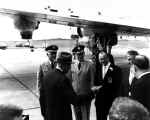
Eisenhower at RAA |
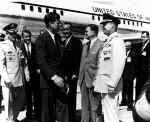
Kennedy at RAA |
Richard M. Nixon visited Huntsville on 18 February 1974 to be the main speaker at the second annual Honor America Day celebration sponsored by the Sertoma Club. He arrived at Redstone Army Airfield and then motored to Big Spring Park in downtown Huntsville. Although he did not land at the arsenal, the installation's airfield was put on "24-hour alert status" to support the Presidential Flight Detachment (5 helicopters and 55 personnel) that accompanied Ronald Reagan on his visit to Decatur, Alabama, in July 1984. Most recently, in June 1990, President George Bush came to Huntsville "...to speak at a Republican campaign luncheon downtown and to make some remarks at MSFC."
Among other important visitors to Redstone were Ladybird Johnson, who came to the arsenal in March 1964 while still the First Lady; and the Apollo 12 crewmen who journeyed to the installation in January 1970, less than 2 months after their lunar voyage. Like Reagan, Marilyn Quayle, wife of the Vice President, came into the city by way of the Huntsville-Madison County Jetplex. In support of her visit, Redstone Army Airfield "...provided a couple of helicopters for her flights around the area," to inspect the aftermath of a killer tornado that hit Huntsville in November 1989.
In addition to visitors from the United States, a large number of foreign dignitaries have been welcomed at the arsenal airfield with full military honors. Officers of the Royal Netherlands Army, the French Army, the Army of the National Republic of China, the Turkish Air Force, the Japanese Ground Self Defense Force, the Army of Spain, the Bolivian Armed Forces, and the Brazilian Command and General Staff College have visited the installation.
Other foreign officials who have flown into Redstone include Signor Manilo Brosio, a former Ambassador of Italy to the United States (May 1958); the Chief of the Budget and Finance Division of the German Federal Ministry of Defense (May 1962); GEN Dr. Hans Speidel, Special Advisor to the German Federal Government for Questions of Atlantic Defense (November 1963); Karl Grumbel, State Secretary, German Ministry of
Defense (December 1964); President Amata Kabua of the Marshall Islands (July 1981); and Israeli Defense Minister Yitzhak Rabin (July 1988). Redstone Army Airfield has even hosted royalty. The Duke of Sparta, Prince Constantine of Greece, who visited Redstone Arsenal in December 1958, subsequently reigned as Constantine II from 1964 to 1973, when he was deposed.
However, the two 10-member Soviet teams, who came to Redstone as part of the initial 60-day baseline verification period, were actually the second group of Russians to land at the airfield. The preceding month a group of Soviet reporters for Tass and Pravda had flown in to Redstone Army Airfield from Washington, DC, with a group of American journalists for a specially organized "Media Day." This event was designed to acquaint the press with the verification process and the sites to be inspected at Redstone Arsenal.
Special Events
Several times in the past, the airfield has been the site of organized special events. One of the earliest of these activities was the release of hundreds of red, yellow, and black helium-filled balloons carrying "tickets to the Moon" which were to help publicize the new One-Time Drive. The latter was a single fund raising drive implemented at Redstone "… to replace the numerous separate campaigns formerly staged by various agencies."
In June 1960, the AOMC Transportation Office sponsored an air show at the arsenal airfield as part of an Ordnance Officer Indoctrination Tour program. Some of the latest Army and Air Force aircraft of that time were displayed, including the C-46 cargo aircraft; a Caribou, then the most modern Army cargo logistical aircraft; a U1-A Otter light cargo/transport aircraft; an L-23 twin-engine passenger aircraft; an H-37 cargo/transport helicopter; an H-19 utility helicopter; and an H-23D observation helicopter, all of which were used by the Army.
Probably the largest of the special events at the airfield open to the public was the assembly organized in August 1962 for internationally known evangelist Billy Graham. Since this was the first time that the Graham Crusade had come to Alabama, a lot of media interest was generated by the event. The reverend's stipulation that he would preach only to an integrated audience, at a time when segregation in the South was still in force, also contributed to the uniqueness of this event.
An integrated crowd estimated at 35,000 people gathered at the airfield on a Sunday afternoon in August to hear not only Graham but "...a 2,100-voice choir made up of volunteers from congregations throughout the Tennessee Valley. The crowd was one of the largest ever on Redstone Arsenal…." Military police stationed at the five gates opened on that Sunday counted a total of 8,713 vehicles between the hours of 8 a.m. and 4:30 p.m. People from as far away as Florida and Arkansas traveled to Redstone Army Airfield, where they sat on blankets, cushions, chairs, stools, concrete, and grass to listen to Graham’s address.
Several organized activities in conjunction with the annual Armed Forces celebration in Huntsville were also held at the arsenal's airfield. As previously mentioned, in May 1963, Redstone Army Airfield was the site of "...the first public Presidential speech ever made at Redstone." John F. Kennedy spoke to an estimated audience of 10,000 as the climax to that year's Armed Forces Day activities.
Armed Forces Day displays and sky diving exhibitions at the arsenal airfield were also opened to the public in May 1964, May 1966, and May 1970. "Hangars at the airstrip contained exhibits from almost every branch of activity at the Arsenal from housekeeping to firing a missile motor. In addition the Navy reserve was represented. In 1966, however, visitors were treated to an unwelcome surprise.
There was one demonstration at the Airstrip which wasn't on the program, and turned out to be not too good of a crowd drawer. It took place in the hangar where snack-bar facilities were set up when a lady skunk and her two little stinkers came out of their den for a look around at the people. However, the people didn't go along; as a matter of fact, they went away... in a hurry.
A more recent event hosted by the airfield occurred during the early morning hours of 11 April 1991. At 12:30 a.m., the airfield's C-23A Sherpa, carrying a special group of passengers, landed at Redstone. On board were members of the 95th Maintenance company (Test Measurement and Diagnostic Equipment) who were returning home from an almost 7-month tour of duty in Saudi Arabia. Although not as large nor as well publicized as some other Desert Storm homecomings, "family members and well wishers" gathered at the airfield with balloons and miniature American flags to give the returning soldiers a heartfelt, jubilant welcome home. Less than a month later airfield personnel "welcomed their boss home… from Saudi Arabia…." Lt. Col. James Kincaid, the airfield director, received a happy welcome [on 2 May) when he and three other soldiers arrived on one of the airfield's Sherpa planes. They were greeted by family members and the airfield's military and civilian people.
Redstone Army Airfield Chronology
4 August 1941
The first commanding officer of Huntsville Arsenal arrived on this day and broke ground for initial construction of the installation1943
An airstrip was built on Huntsville Arsenal to accommodate the planes used to test clusters of incendiary bombs and smoke grenades.May 43
An Army Air Forces (AAF) detachment-- the 6th AAF Base Unit (Proving Ground Detachment) --was first stationed at Huntsville Arsenal. It consisted of three officers, three enlisted men, and two planes (a B-26 and an L-20).May 43
The South Bombing Range, an additional proofing area constructed on Huntsville Arsenal, was completed.July 43
Construction of a 500-foot concrete bombing mat at Huntsville Arsenal was finished. Also during this period, a simulated village was built on the installation. Known as "Little Tokyo," the village contained about 50 wooden shacks with 3 streets, all of which were obliterated by February 44.1943-1945
Army bombers dropped more than 8 million pounds of chemical munitions at Huntsville Arsenal.January-February 44
A 200-foot wooden structural target was erected at Huntsville Arsenal for the proofing of 500-pound M-76 incendiary bombs.1 April 44
The 618th AAF Base Unit (Proving Ground Detachment) was assigned to Huntsville Arsenal. It absorbed the 6th AAF Base Unit the following month.27 June 44
Three Huntsville Arsenal aviators were killed in the crash of B-26 Martin Marauder during a routine proof testing flight. The plane, which developed engine trouble after attaining an altitude of 3,000 to 4,000 feet, burst into flames, while still airborne. It crashed in a cotton field north of the Huntsville-Athens Highway. After impact, the plane's cargo of bombs exploded because of the fire.10 August 44
The east-west road connecting Rideout Road with the airfield was named Hale Road in honor of 1LT Emmett J. Hale, pilot, who was killed in the crash of the B-26 bomber in June 44.18 November 44
The Huntsville Arsenal Officers' Picnic Park was redesignated Loeffler Park in memory of 2LT Jerome Loeffler, bombardier, who was killed in the crash of the B-26 bomber in June 44.1945
Near the end of WWII, a rectangular airplane hangar open at both ends was built at the airstrip when fuzes had to be flown into Huntsville Arsenal.March 45
Bombs proof tested at Huntsville Arsenal were used in the first all-incendiary raid on Japan during this month.20 April 45
SGT Antone Valim, engineer, was honored when the Huntsville Arsenal reservoir, located on the west slope of Madkin Mountain, was renamed in his memory. Sergeant Valim was one of three crew members killed in the crash of the B-26 bomber in June 44.28 October 45
The 618th AAF Base Unit, whose home base was Eglin Field, Florida, ended its tour of duty at Huntsville Arsenal.October 4 to February 56
With the cessation of incendiary testing and the departure of the 618th AAF Base Unit, the Huntsville Arsenal airstrip was largely vacated, although it continued to serve as a landing field for transient aircraft.30 June 49
On this date, Huntsville Arsenal ceased to exist as a separate installation. Responsibility for the post was transferred to neighboring Redstone Arsenal. Effective 1 April 50, the Department of the Army officially discontinued Huntsville Arsenal and consolidated the major portions of its land and facilities with Redstone. Among the areas that were to be fully utilized by the latter installation was the arsenal airstrip.November 55
MG John B. Medaris, first commanding general of the U.S. Army Ballistic Missile Agency (ABMA), decided to create an Aviation Section within this new Army organization to be located at Redstone Arsenal, Alabama. Medaris made this decision 2 months before he actually began directing the long-range missile development projects at the arsenal.1 February 56
ABMA was established at the Redstone Arsenal complex.15 February 56
Effective 1200 hours, BG Holger N. Toftoy, Commander of Redstone Arsenal, turned over the airfield to ABMA. The facility became part of the Aviation Section of the Transportation Branch, Headquarters Commandant.12 April 56
Huntsville city officials met with the ABMA Commander to discuss the establishment of a federal airway through Huntsville. Because such an airway would be mutually beneficial for the arsenal and the city, the commander agreed to build a control tower at Redstone Army Airfield. It would handle both military and commercial air traffic pending the establishment of facilities at the Huntsville Airport.24 April 56
The Civil Aeronautics Authority (CAA) agreed to establish an airway through Huntsville and control air traffic in the Huntsville area from Memphis, Tennessee, via a tower at Redstone Army Airfield. This arrangement would last until a permanent facility was erected at the municipal airport.May 56
The Aviation Section was moved from the Transportation Branch and became a separate element under the jurisdiction of the Headquarters Commandant.May 56
CPT William H. Ballard, the first officer to head the ABMA Aviation Section, was appointed.May 56
By this time, an operations building had been constructed at the airfield. The new building housed office equipment, a passenger waiting room, and communications equipment. In addition, two 12,000-gallon underground gasoline tanks were installed and an oil storage facility was built.May 56 to September 59
In the first 42 months of the airfield's all-weather operations, the U.S. Army Ordnance Missile Command (AOMC) Aviation Section logged more than 3.5 million passenger miles without mishap.July 56 to November 69
The airfield was a 24 hour a day, seven day a week operation after its control tower was activated in 1956. This schedule remained in effect for 13 years, until it was changed in 1969 to its current operating schedule of 13 hours a day, 5 days a week.June 56
The Army erected a freestanding, 25-foot, wooden and open steel frame tower to house the airfield's new approach controllers.1 July 56
Redstone Army Airfield's control tower officially began operating at 2300.2 July 56
Ceremonies marking the opening of the renovated and expanded Redstone Army Airfield were held on this date. A light plane "riding a beam" sent out from the new control tower skimmed down and cut with its propeller the ribbon strung across the runway. The ABMA Commander, using a conventional pair of scissors, completed the dedication ceremony by snipping a ribbon on the newly opened control tower.1957
The Aviation Section borrowed two helicopters from Fort Benning, Georgia, and established an emergency air transportation system between the ABMA and Redstone Arsenal headquarters buildings. This action was taken after flood waters threatened to divide the arsenal by overflowing onto the last road connecting the two areas.1957
The Redstone Arsenal Flying Club was organized. Based at the arsenal, the organization relocated to the Huntsville Airport the next year.June 57
MG John B. Medaris, one of the Army's highest ranking officers to complete flight training, received his silver pilot's wings from the Army Aviation School at Fort Rucker, Alabama. In his 4 years as the Commander of ABMA and later AOMC, Medaris piloted Army aircraft a total of 1,237 hours.1958
MG John A. Barclay, ABMA Commander from 1958 to 1960, as well as Deputy Commanding General of the AOMC from April 60 to June 61, was the second of Redstone Arsenal's highest ranking officers to win his pilot's wings.1958
Military police at Redstone Arsenal made use of a small, two-seat helicopter to patrol the post's roads. The arsenal was the only military installation in the United States using such a system at that time. The helicopter was also used to conduct traffic surveys.January 58
A ground control approach landing system was inaugurated at the airfield.9 May 58
After the activation of AOMC in March 58, ABMA became a subordinate element of the new organization. The Aviation Section was assigned to the AOMC Adjutant General for administration, but it was placed under the operational control of the AOMC Transportation Office.December 59
The support agreement between the Army and the National Aeronautics and Space Administration (NASA) was signed during this month. Under the terms of this unique agreement, Redstone Arsenal was to provide air support for the civilian agency. Redstone is the only Army airfield with a NASA tenant.1960
By this time, AOMC aircraft had the second highest amount of flying hours per month of all Army installations worldwide.15 April 60
The mission and functions of the Aviation Section, AOMC Adjutant General, were transferred to Redstone Arsenal. The section was redesignated the USAOMC Army Aviation Division and answered directly to the post's Deputy Commander.August 60
A telephone crash rescue system was installed at Redstone Army Airfield.8 September 60
The first sitting U.S. president to visit Redstone Arsenal landed at the airfield on this date. Dwight D. Eisenhower came to dedicate NASA's George C. Marshall Space Flight Center.November 60
The Army Corps of Engineers awarded a contract for strengthening and extending the airfield runway by 2,300 feet to enable it to handle the large planes -used to ferry missiles and missile components.May 61
Redstone Arsenal made local aviation history when two transatlantic passenger-craft of the German Lufthansa Air Line flew into the airfield to take 155 German Air Force missile students and their families back home from the Army Ordnance Guided Missile School. These were the first flights ever made from Redstone by a foreign commercial airline; the largest chartered flights ever to originate at Redstone; and the first time that passengers embarking at Huntsville flew directly to an overseas destination in Germany.1 June 61
A closed hangar for aircraft maintenance was completed.1 November 61
The Aviation Division was placed under the jurisdiction of the Post Transportation Division, an element of the Army Ordnance Missile Support Agency (AOMSA). The latter had replaced Redstone Arsenal as the support element of AOMC. The division was renamed the USAOMC Army Aviation Branch.1962
The USAOMC Army Aviation Branch was redesignated the Army Aviation Branch. Its four sections were merged into two: Supply & Maintenance and Schedule & Operations.August 62
Internationally known evangelist Billy Graham made his first appearance in Alabama at an assembly held at Redstone Army Airfield. An integrated crowd, estimated at 35,000 people, gathered to hear Graham's address.September 62
During this month, President John F. Kennedy came to Redstone Arsenal for the first time. He returned on 18 May 63 to deliver a speech at the airfield as part of that year's Armed Forces Day celebration. This was the first presidential speech ever made at the arsenal.October 65
The airfield handled commercial aircraft belonging to Eastern Airlines and United Airlines for one day after the Huntsville/Madison County Airport's main runway was blocked by an airliner. The plane had been damaged when its nosewheel apparently collapsed during takeoff. The Army airfield handled a total of eight commercial flights during the one day that the municipal facility was closed.20 December 66
The U.S. Army Missile Command (MICOM) Staff Aviation Office was provisionally established. The new element, which functioned as a Special Assistant, served as the principal staff advisor to the MICOM Commander, exercising staff supervision and coordination over MICOM's aviation activities.21 May 67
The Staff Aviation Office became permanent.1967-1968
A series of airborne tests conducted at Redstone Arsenal of particular historical significance for the Army involved successful test firings of the TOW missile system in its airborne configuration. The two aircraft used in the testing became the first helicopters committed to combat in Vietnam in 1972, making TOW the first Army guided missile to be fired in combat by American soldiers. Although not assigned to Redstone, the helicopters flew out of Redstone Army Airfield during the tests.1968
By this time, there were four hangars lining the airfield's taxi strip, two used by airfield personnel; one belonging to Marshall Space Flight Center (MSFC); and one supporting MICOM's research and development effort.1969
During the closing months of this year, the Staff Aviation Office ceased to exist as a separate Special Assistant, even though the head of the Army Aviation Branch continued to serve as the Staff Aviation Officer.1970
There was some discussion at this time about moving MICOM's flight operations from Redstone Army Airfield to the Huntsville -Madison County Jetplex, once the latter acquired radar facilities. Security issues for the Army as well as logistics problems for MSFC were key reasons in the command's decision not to move its aviation activities.January 70
By this time, the Air Traffic Control Section of the Aviation Branch was handling between 800 and 1,000 flights every month.4 January 71
The Redstone Arsenal Support Activity (RASA) was established. As part of this new organization, the Army Aviation Branch became the Flight Operations Division.1974
The Redstone Arsenal Flying Club returned to the arsenal airfield.18 February 74
President Richard M. Nixon visited Huntsville to be the main speaker at the second annual Honor America Day celebration. He arrived at Redstone Army Airfield and then motored to Big Spring Park in downtown Huntsville.1977-1979
After MICOM was split into the Missile Readiness Command (MIRCOM) and the Missile Research and Development Command (MIRADCOM), Redstone Army Airfield fell under MIRCOM's jurisdiction.1978
By this time the aviation facilities at Redstone Army Airfield were no less complete than those of the civilian jetplex, even though the former was a relatively small military airfield.March 78
The space shuttle Enterprise, mounted on the back of a Boeing 747 jet transport, landed at Redstone Army Airfield.June 80
As part of the arsenal's continuing effort to keep its airfield up-to-date, the old air traffic control tower was torn down to make way for a new structure.June 81
The first of its type in the continental United States, Redstone Army Airfield's new modular control tower was dedicated during this month.1983
The Federal Aviation Administration (FAA) selected Redstone Army Airfield to be a flight service station sub facility, based on the amount of its air traffic and hours of operation.1983
The Flight. Operations Division turned over its YC-7 Caribou (No. 57-3080) aircraft to the aviation museum at Fort Rucker, Alabama. Put into service in 1957, this particular plane was the second Caribou added to the Army's fleet of aircraft. The first Caribou in Vietnam, No. 57-3080, also served as the flagship for the president of South Vietnam. The aircraft flew about 10,000 hours in its 26 years of Army service.21 July 86
Construction began on a hangar missile test facility located at the airfield. The new building provided space for the Research, Development and Engineering (RD&E) Center to test rotary wing aircraft with missile systems. It was completed in March 88.1987
The Flight Operations Division was redesignated the Flight Operations Directorate as part of RASA's compliance with the Army's Standard Installation Organization (SIO) structure.May 88
The control tower's 35-year-old metro consoles were replaced with a modern air traffic control communication switching system. The new arrangement provided better, faster communication with both aircraft and ground units. It became operational in June 88.June 88 to September 89
MG August M. Cianciolo, the last of Redstone's flying generals, served as MICOM Commander during this period. Unlike Medaris and Barclay, Cianciolo earned his pilot's wings before he was assigned to Redstone Arsenal.16 July 88
A notable first for the installation occurred when the initial group of Soviet inspectors to come to Redstone Arsenal arrived at the airfield. Their visit was part of the verification procedure on which the Intermediate Range Nuclear Forces (INF) Treaty between the United States and the Soviet Union rested.1 April 89
Redstone Army Airfield accomplished a feat only one other airfield Armywide had managed: the cross training and qualification of its military air traffic personnel in both tower and radar control operations.September 89
The Army's last C-7A Caribou, which was stationed at Redstone Army Airfield until May 91, was used to assist hurricane relief efforts in San Juan, Puerto Rico, in the aftermath of Hurricane Hugo.June 90
President George Bush came to Huntsville to speak at a Republican campaign luncheon downtown and to make some remarks at Marshall Space Flight Center. During this visit, Air Force One's landing and take-off were handled by Redstone Army Airfield.18 May 91
The airfield turned in its C-7A Caribou, the last of this type of cargo aircraft on active duty with the Regular Army. The plane became a part of the Texas Aviation Historical Society's Museum at a dedication ceremony held on this date.

